with Kentucky Explorer
duncan hines days
Marksbury Farm Polly’s
Pickles

Midway University’s Equine Studies Program celebrates 50 years
MAY 2024
THE FOOD ISSUE
PGA
BONUS
Championship Course Guide to Valhalla
The Filson Historical Society 140 th anniversary Henderson Memorial Day service
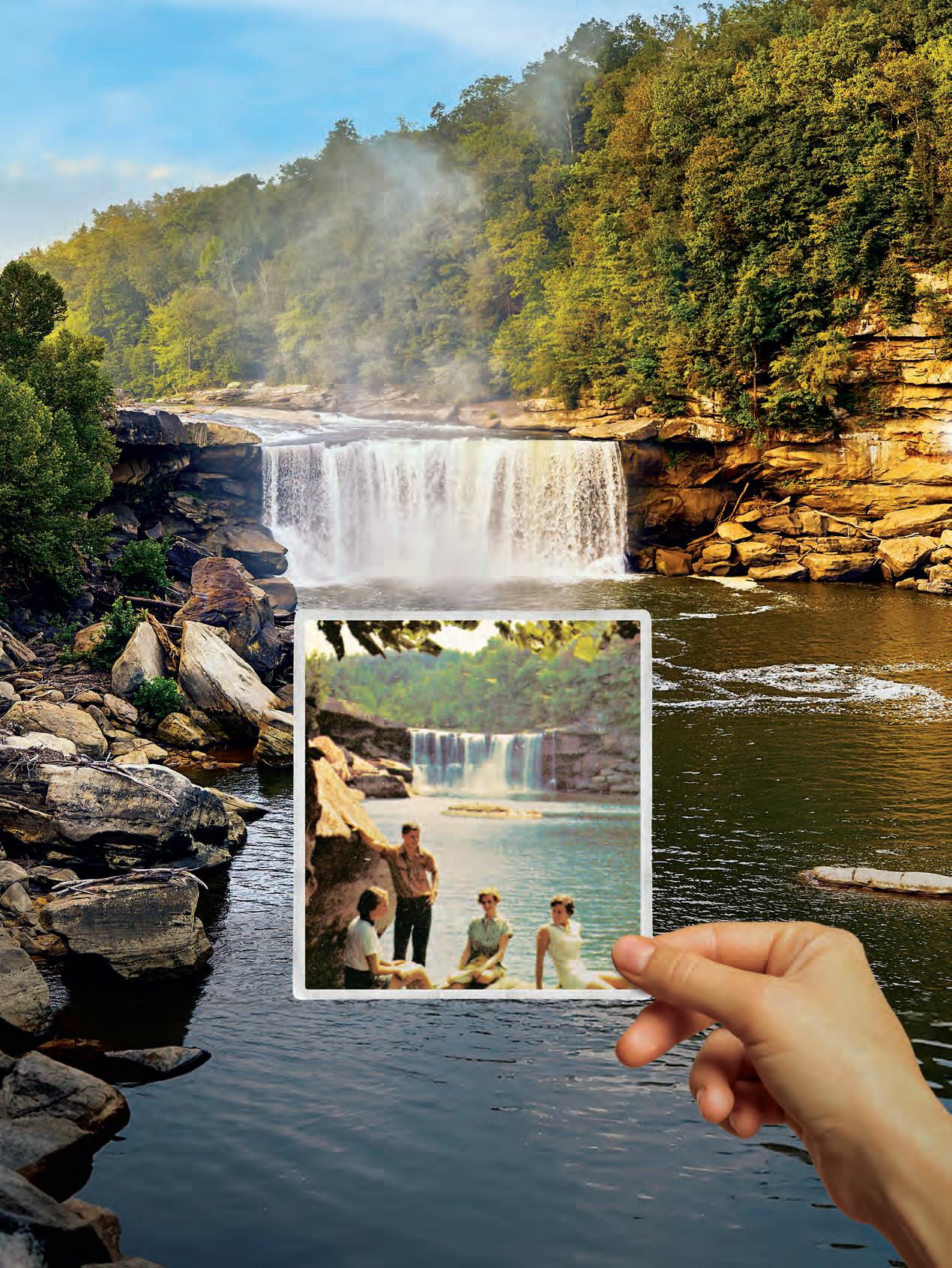
Dedicate your weekends to creating memories that last a lifetime. Plan your spectacular getaway today at Parks.KY.gov.
100 Years of Unforgettable Moments
14 Pastured on Bluegrass Garrard County meat processor Marksbury Farm prioritizes
systems and animal
24 A Big Dill For a Louisville mother and daughter, a traditional family treat evolved into a popular pickle product
28 For the Love of the Horse Midway University’s Equine Studies program marks 50 years of hands-on learning
32 Paying Respect Henderson’s moving Memorial Day service is the work of a small army of volunteers
36 The Past Is Present The Filson Historical Society remains true to its mission of preserving and sharing Kentucky history while expanding its reach
39 Conquering Valhalla A special hole-by-hole guide of the 2024 PGA Championship course


Celebrating Duncan Hines Bowling Green will host a weeklong festival to honor the native son who modernized American dining

What complements The Food Issue? Drinks, of course! Check out our special accompanying supplement, DRINK LOCAL , our guide to sippin’ in the Bluegrass State.
DEPARTMENTS 2 Kentucky Kwiz 3 Readers Write 4 25th Anniversary 6 Music 8 Cooking 61 Kentucky Explorer 72 Books 73 Past Tense/ Present Tense 74 Gardening 76 Field Notes 78 Calendar 80 Vested Interest
welfare
natural
kentuckymonthly.com 1 in this issue 20 Duncan Hines’ Southern Coconut Cake. Find the recipe at readyseteat.com MAY ON THE COVER
Drink local
Test your knowledge of our beloved Commonwealth. To find out how you fared, see the bottom of Vested Interest.
1. Congressman Alney McLean, the namesake of McLean County, never could have imagined the fame his farm would attain after his son discovered coal near which forlorn Muhlenberg County town?
A. Paradise
B. Airdrie
C. Rochester
2. When John Prine, considered “the Mark Twain of songwriting,” died in 2020 from complications of COVID-19, half of his ashes were buried next to his parents’ graves in Chicago. The other half were spread in which Kentucky river?
A. Rough
B. Barren
C. Green
3. In 1866, a year after the Civil War ended, which Kentucky college had more Black students than white?
A. Kentucky State University
B. Berea College
C. Simmons College
4. Carter Woodson was the namesake of a Lexington college preparatory academy and credited with establishing what became Black History Month, but he also was the first person born of enslaved parents to obtain what?
A. A book-publishing contract
B. A doctorate in history
C. A Medal of Honor
5. The cheapest seat for this year’s Kentucky Derby is $166. What is the average seat cost?
A. $1,859
B. $2,859
C. $3,859
6. A trace of snow on Derby Day is rare but not out of the question. The record for the latest snowfall in Kentucky was set in 1894 with Lexington, Harrodsburg and Mount
Sterling getting as much as 6 inches on what date?
A. May 10
B. May 15
C. May 20
7. From 1776-1780, Kentucky County (aka Kentucke County) was part of Virginia. The county seat was Oldtown, which later was renamed what?
A. Danville
B. Harrodsburg
C. Frankfort
8. From 1986-1993, Franklin native Annie Potts starred in 163 episodes of which popular television show?
A. Golden Girls
B. Magnum, P.I.
C. Designing Women
9. What did Sam C. Ford and Preston H. Leslie have in common besides being from Clinton County?
A. Fulbright scholars at the University of Kentucky
B. Gemini astronauts
C. Montana governors

© 2024, Vested Interest Publications Volume Twenty-Seven, Issue 4, May 2024
Stephen M. Vest Publisher + Editor-in-Chief
Editorial
Patricia Ranft Associate Editor
Rebecca Redding Creative Director
Deborah Kohl Kremer Assistant Editor
Ted Sloan Contributing Editor
Cait A. Smith Copy Editor
Senior Kentributors
Jackie Hollenkamp Bentley, Jack Brammer, Bill Ellis, Steve Flairty, Gary Garth, Jessie Hendrix-Inman, Mick Jeffries, Kim Kobersmith, Brigitte Prather, Walt Reichert, Tracey Teo, Janine Washle and Gary P. West
Business and Circulation
Barbara Kay Vest Business Manager
Advertising
Lindsey Collins Senior Account Executive and Coordinator
Kelley Burchell Account Executive
Teresa Revlett Account Executive
For advertising information, call 888.329.0053 or 502.227.0053
KENTUCKY MONTHLY (ISSN 1542-0507) is published 10 times per year (monthly with combined December/ January and June/July issues) for $25 per year by Vested Interest Publications, Inc., 100 Consumer Lane, Frankfort, KY 40601. Periodicals Postage Paid at Frankfort, KY and at additional mailing offices.
POSTMASTER: Send address changes to KENTUCKY MONTHLY, P.O. Box 559, Frankfort, KY 40602-0559. Vested Interest Publications: Stephen M. Vest, president; Patricia Ranft, vice president; Barbara Kay Vest, secretary/treasurer. Board of directors: James W. Adams Jr., Dr. Gene Burch, Gregory N. Carnes, Barbara and Pete Chiericozzi, Kellee Dicks, Maj. Jack E. Dixon, Bruce and Peggy Dungan, Mary and Michael Embry, Judy M. Harris, Greg and Carrie Hawkins, Jan and John Higginbotham, Frank Martin, Bill Noel, Walter B. Norris, Kasia Pater, Dr. Mary Jo Ratliff, Barry A. Royalty, Randy and Rebecca Sandell, Kendall Carr Shelton and Ted M. Sloan.
Kentucky Monthly invites queries but accepts no responsibility for unsolicited material; submissions will not be returned.
10. True or False: Taylorsville is named after President Zachary Taylor kentuckymonthly.com

 Celebrating the best of our Commonwealth
Celebrating the best of our Commonwealth
kentucky kwiz 2 KENTUCKY MONTHLY MAY 2024
Readers Write
A Treat From the Banana Capital
My husband and I were so pleased when Stephen Vest approached our table at the Kentucky Monthly reception in Paducah on Feb. 23. We thanked him for recognizing that the “real” Western Kentucky does not end in Bowling Green, even though I’m a proud Western Kentucky University grad.
We live in the very southwest corner of the state—in Fulton County. I’m a retired principal at Fulton’s Carr Elementary, where one can walk out the front door of the school and cross the street into Tennessee. The Madrid Bend portion of our county cannot be accessed without leaving Kentucky and going into Tennessee to get there.
As I told Stephen, Fulton proudly wears the title of International Banana Capital, and we celebrate each fall with a weeklong Banana Festival. I also
happened to mention the fact that I was the 2023 grand prize winner of the Banana Festival Bake-off, with my Drunken Monkey Banana Pudding Dip. He insisted that I send the recipe.
I tweaked a Drunken Monkey Banana Pudding recipe, turning it into a dip, so I guess it wouldn’t qualify as an “original” recipe for the magazine’s recipe contest. I entered the contest years ago, and my entry was published, but it was so many years ago, I can’t even remember what I entered.
Susan Caldwell Black, Fulton
Drunken Monkey Banana Pudding Dip
1½ cup heavy whipping cream
½ cup Jackson Morgan Banana Liqueur
1 box instant banana pudding mix
8 ounces cream cheese, softened
½ cup powdered sugar
½ tub Extra Creamy Cool Whip
3 bananas, chunked Biscoff cookies
1. Beat heavy whipping cream and liqueur until thick. Beat in instant pudding.
2. In a separate bowl, beat together cream cheese and sugar. Fold the two mixtures together.
3. Fold in Cool Whip and chill until ready to serve.
4. When ready to serve, fold in bananas
5. Serve with Biscoff cookies for dipping
Everyone associates vanilla wafers with banana pudding, but I discovered Biscoffs when I was looking for a sturdier and larger cookie to use with the recipe. I’ll never go back to vanilla wafers!
I hope you give the pudding dip a try.
We Love to Hear from You! Kentucky Monthly welcomes letters from all readers. Email us your comments at editor@kentuckymonthly.com, send a letter through our website at kentuckymonthly.com, or message us on Facebook. Letters may be edited for clarification and brevity.


’s

Counties mentioned in this issue... kentuckymonthly.com 3
UNITING KENTUCKIANS EVERYWHERE.
Find more at kentuckymonthly.com. Use your phone to scan this QR code and visit our website. Follow us @kymonthly This handy guide to sipping in the Bluegrass State spotlights local breweries, wineries and, of course, distilleries. Discover unique ways to drink in Kentucky, creative cocktail recipes and more.
Kentucky
Drink Local
The
Gift Guide
finest
gifts
Commonwealth has to offer.
Kentucky Monthly
annual gift guide highlights some of the
handcrafted
and treats our















madisonville
Ferrell’s Snappy Service
112 N Main Street, Madisonville
Open 24 hours! A Madisonville landmark, Ferrell’s Snappy Service has been flipping burgers and frying potatoes since 1929!
MadCity Drinks and Treats
17 E Center Street, Madisonville
Mahr Park Arboretum
55 Mahr Park Drive, Madisonville
Mahr Park Arboretum is a 265-acre park open from dawn to dusk 7-days a week.
Western Kentucky Brewery Hop
From Owensboro to Paducah, this trail includes the best breweries in Western Kentucky! westkybrewery.com

Madisonville and Hopkins County are home to a large variety of outdoor recreational activities, including scenic trails, tranquil lakes, rolling grasslands and dense forests. Madisonville offers a selection of delectable dining, a state-of-theart fine arts theater and gallery, and a wide selection of comfortable and hospitable accommodations.
Kentucky Monthly continues our 25th Anniversary festivities with a reception at Ruby Lodge. Hosted by the Hopkins County Genealogical Society and sponsored by an anonymous donor and Kesterson’s Corner Antiques.
MAY 11 • 2:00 PM –4:00 PM Free, Reservations Required RSVP to 270.327.1876 or hcgs_ky@yahoo.com by May 3.
Ruby Lodge at Spring Lake
367 Spring Lake Street, Madisonville madisonvillebandb.com
We’re celebrating all year! Stay tuned for more 25th Anniversary news, including meetups and suggestions for activities in all our host cities. We will feature them in every issue of the magazine and online at www.kentuckymonthly.com
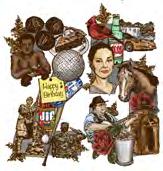


HOPKINS COUNTY GENEALOGICAL SOCIETY
KESTERSON’S CORNER ANTIQUES
4 KENTUCKY MONTHLY MAY 2024
meet us in...
SAVE THE DATE
MEET US IN HARRODSBURG JUNE 11. more to explore...
...
MAY 11 • RUBY LODGE AT SPRING LAKE
from the May archives celebrating 25
Ruby Lodge
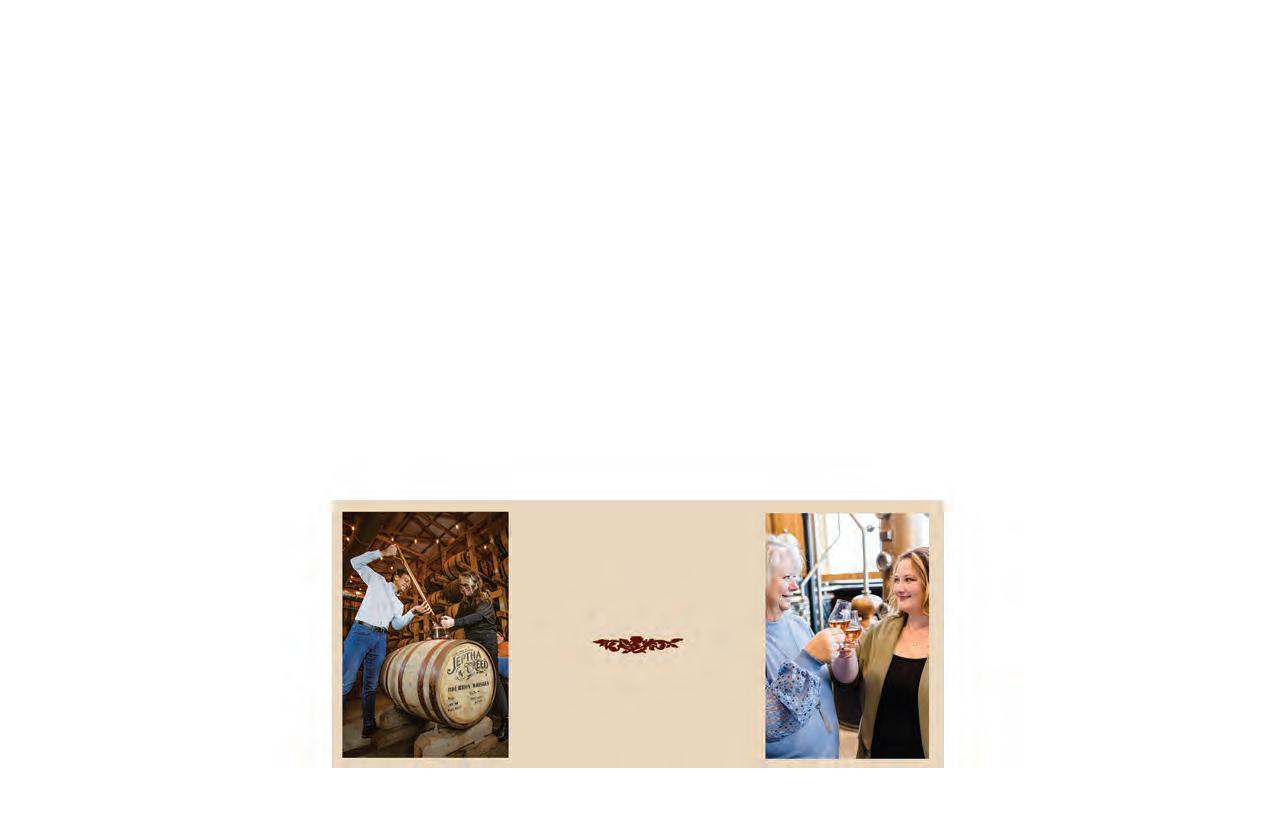


Granddam is The Manchester’s expansive Southern-inspired dining hall, serving up nostalgic regional cuisine with unexpected twists and a focus on local farms and purveyors. We’ve got woodfire cooking, tableside preparations, and a spirited cocktail program inspired by the farms of the Bluegrass. Come say hey, at your leisure.
RESERVATIONS AVAILABLE
While away warm Kentucky nights at Lost Palm, our tropical, pineapple-scented rooftop paradise. Inspired by 1960s South Florida — Lexington’s Southern Sister in Horses — Lost Palm’s indoor outdoor drinking parlor features a flamboyant tiki cocktail program and light bites.
RESERVATIONS AVAILABLE ON OPENTABLE OR RING US AT (856) 785-3905

PARADISE AWAITS
FEBRUARY 2013 • KENTUCKY MONTHLY 5
CULTURALLY INSPIRED SOUTHERN CUISINE
ON OPENTABLE
RING US AT (859) 785-3905
OR
FIND US AT 941 MANCHESTER ST. LEXINGTON KY 40508 PHONE: +1 859-785-3900 ONLINE: WWW.THEMANCHESTERKY.COM FOLLOW: @THEMANCHESTERKY
by Laura Younkin
Fierce Talent
Now a resident of Los Angeles, Abigail Fierce is accustomed to hearing, “You’re not from LA” when she meets new people. And she’s fine with that. She’s from Kentucky, and she knows her roots have affected everything from her musical growth to her work ethic.

Abigail Fierce will appear in the Back Porch Concert Series on July 13 from 7-9 p.m. The free event is located at 7751 West Highway 42 in Goshen.
Fierce is a 22-yearold singer and actor who grew up in Louisville and knew at a young age she wanted to perform. Her family took a little longer to embrace her dream. Fierce said her mother was supportive. “She gave in a little bit,” Fierce said. “We came out [to Los Angeles] for a couple months a year,” to begin with. On one visit, Abigail got a manager and an agent, and her mother was convinced that Abigail’s dream just might work out after all. So, they moved to LA.
Fierce uses the name Abigail Killmeier when acting but found it easier to go by Abigail Fierce for her music career. She hopes to use Fierce for all her work eventually, as it’s a family name. Fierce has 4.7 million streams on Spotify, had a recurring role as Wendy in Hulu’s Love, Victor, and has appeared on NBC’s This Is Us
Her latest acting role is in the 50 Cent-produced thriller Skill House. Fierce described it as a horror movie, “but they’re kind of playing on the influencer culture” and how far people are willing to go to get likes. She said it’s slated for a 2024 release.
Fierce appreciates being able to act and said she’s been playing music for a long time. “I’m able to be myself with my music,” she said. She describes her music as “Ed Sheeran and Taylor Swift mixed with Alanis Morissette and Courtney Love.” While she loves storytelling songs, she’s a big fan of ’90s rock and tries to blend the two for a more updated sound.
Unlike many Kentucky musicians, she was not introduced to music by a family member. “Music was not a thing in my house growing up. We had periodic table placemats,” Fierce said. It was the offspring of a Kentuckian who started her on her musical path. Billy
Ray Cyrus’ daughter, Miley, and her TV show Hannah Montana enthralled a young Fierce.
As a child, Fierce found a box of CDs by a dumpster. It was full of early 2000s music such as Plain White T’s and Michelle Branch Fierce couldn’t believe her good fortune, telling herself, “This is my lucky day.”
Once she was smitten with singing and acting, she found mentors. She took piano lessons from Kimmet Cantwell, of the locally famous duo Kimmet and Doug, and worked on musical theater skills with Michael and Annie Bolden. Michael was a musical director for The Stephen Foster Story in Bardstown, and his wife gave Fierce voice lessons. “[Annie] is the best singer I’ve ever heard, and I wouldn’t be able to sing pop-rock songs healthily without the solid foundation she gave me,” Fierce said.
Fierce knows these Kentucky musicians helped mold her. She also knows that being from Kentucky has enabled her to stay level-headed. “I love being outdoors. Nature keeps me grounded. I credit part of that from being from Louisville,” she said. She still misses the kayaking trips she took with her brother. She credits her mother for letting her know that “hard work and obstacles keep you grounded. If you start to feel too big for your britches,” life has a way of bringing you back down.
Fierce learned in LA that some of her upbringing wasn’t normal by coastal standards. “I took horse-riding lessons as a kid. I realize now that’s a very Kentuckycentric thing,” she said. When people find out she’s from Kentucky, they ask her what her favorite bourbon is. She doesn’t have an answer yet because she’s only 22 and hasn’t been of drinking age long enough to explore the possibilities.
Fierce said having fans tell her how much one of her songs meant to them is what she loves best about making music. She’ll be back in Kentucky in July to visit her father and to share those songs.
music
6 KENTUCKY MONTHLY MAY 2024

GUEST, LEAVE





AS
AS AN
Wilderness Trail® Kentucky Straight Bourbon Whiskey 50%alc./vol.(100 proof). Distilled and Bottled by Wilderness Trail Distillery, Danville, KY. ®2024 Campari America, New York, NY. Drink Responsibly VIST US AT WILDERNESS TRAIL DISTILLERY
COME
A
EXPERT

Delectable Dishes
PHOTOS BY WOODY PHILLIPS
cooking
8 KENTUCKY MONTHLY MAY 2024
Sweet & Spicy Smoked Gouda Bacon Dip 2024 Kentucky Monthly Reader Recipe Contest
2 8-ounce packages cream cheese
1 cup mayonnaise
1 cup sour cream
1 teaspoon fresh horseradish, finely grated and chopped
2 teaspoons powdered sugar
16 ounces smoked gouda, shredded
1 pound bacon, cooked and chopped
3 scallions, chopped and divided
Freshly ground black pepper, to taste
Crackers, melba rounds, toasted baguette slices or fresh crudité for serving
At Kentucky Monthly , one of our favorite times of the year is Reader Recipe Contest season. Competition was fierce this year, with “mmmm, this one’s delicious” and “oh, I could eat the entire bowl” heard among the judges.
Chef John Foster , director of the Culinary Arts Program at Lexington’s Sullivan University and owner of The Sage Rabbit restaurant in Lexington, headed the preparation of the dishes, which were judged on appearance, creativity, ease of preparation and—weighted highest of all—flavor.
Thank you to all who entered, and congratulations to the winner and finalists!
GRAND-PRIZE WINNER
JULIE HOOK
CUNNINGHAM, CARLISLE COUNTY
1. Preheat oven to 400 degrees.
2. In a large bowl, add cream cheese and microwave for 30 seconds or until softened and easy to stir. Add mayonnaise, sour cream, horseradish and powdered sugar, and whisk until smooth.
3. Reserve 1/3 cup of shredded gouda, ¼ cup of chopped bacon and 2 tablespoons of the chopped scallions for later.
4. Add black pepper and the remaining cheese, bacon and scallions to the cream cheese mixture and stir to combine.
5. Transfer dip to an ovenproof dish and sprinkle with the reserved cheese and bacon. Bake for 30 minutes or until golden brown and bubbly. Remove from oven and sprinkle with the reserved scallions.
6. Serve immediately with crackers, melba rounds, toasted baguette slices or fresh crudité.
Note: You may add 1 cup of crabmeat or cooked chicken to dip mixture before baking, if you like.

A lifelong Kentuckian, Julie says this about her winning recipe:
“It’s a delicious, quick appetizer, and you can easily double the recipe.”
As the Reader Recipe Contest GrandPrize Winner, Julie and a guest will enjoy an evening and breakfast the following morning at the stately, elegant Riverside Inn Bed & Breakfast in Warsaw. riversideinnbb.com

SPECIAL THANKS TO
Chef John Foster for his competence and professionalism in preparing the recipes; Sullivan University’s Marika Wesolosky for helping coordinate the contest; photographer Woody Phillips, who graciously agreed to take on this gig at the last minute; Sullivan University for the use of one of its Culinary Arts Program kitchens and always being a terrific collaborator; Riverside Inn Bed & Breakfast for providing the grand prize; and judges Paul Gregory Sue-Sue and Steve Hartstern Deborah Kohl Kremer and Kay Vest
kentuckymonthly.com 9
FINALIST
MERRITT BATES-THOMAS OWENSBORO

Luscious Lemon Blueberry Cake
½ cup all-purpose flour
1 cup super-fine almond flour
1 teaspoon baking powder
½ teaspoon kosher salt
1 stick (¼ pound) butter, softened
2/3 cup granulated sugar
2/3 cup lightly packed brown sugar
2 large eggs, room temperature
½ cup plain Greek yogurt
2 teaspoons lemon extract
1 tablespoon lemon zest
¾ cup fresh blueberries, rinsed well and sprinkled with an additional 1 tablespoon granulated sugar
½ cup honey
½ cup water
Powdered sugar, optional
1. Preheat oven to 350 degrees. Grease an 8-inch round cake pan well with butter and dust it with flour to ensure the cake doesn’t stick to the side or bottom of the pan.
2. In a mixing bowl using a whisk, combine both flours, baking powder and salt.
3. Add softened butter and both sugars to the bowl of a stand mixer. Using the paddle attachment, cream the mixture together for a few minutes until light and fluffy. Scrape down the sides of the bowl as needed.
4. Beat in the eggs one at a time until incorporated. Add the Greek yogurt, lemon extract and zest, and mix until smooth. Add the dry ingredients and mix just to combine and remove any lumps. Scrape down the sides of the bowl as needed.
5. Transfer the batter to the cake pan and spread into an even layer. Bake
on the middle rack of the oven for 35 minutes, until golden and just set in the middle. Cool the cake in the pan for 10 minutes. Run a butter knife around the edges of the pan. Place a dinner plate on top of the cake pan and flip the cake over so it releases. Repeat the process by putting the serving plate or cake stand on top of the bottom of the cake and flip it again. Allow cake to cool fully.
6. Once cake has cooled, combine the honey and water in a 12-inch skillet and bring the mixture to a boil over medium-high heat. Reduce the heat to medium and cook for about 5 minutes until reduced. Allow mixture to cool for 5-8 minutes.
7. Spoon the honey mixture over the cake. Dust with powdered sugar, if desired, just before serving.
10 KENTUCKY MONTHLY MAY 2024 cooking
MARY PERKINS-LUKETICH LEXINGTON
Best Boozy Brownies
2½ cups granulated sugar
2/3 cup vegetable oil
¼ cup bourbon or bourbon cream
¼ cup milk
4 teaspoons pure vanilla extract
2 large eggs
2 cups all-purpose flour
1 cup natural unsweetened cocoa powder
¼ teaspoon baking soda
1 teaspoon salt
¼ teaspoon baking powder
Finely grated dark and white chocolate
1. Preheat oven to 350 degrees.
2. Generously grease a 9- by 13-inch baking pan and line with parchment paper.
3. In a medium-sized mixing bowl, combine the granulated sugar with oil, bourbon or bourbon cream, milk and vanilla extract, and beat together until well combined.
4. Add the eggs and beat until just combined, about 30 seconds or so. Place the dry ingredients in a separate bowl and stir to combine. Add the dry ingredients to the batter and mix just until combined. DON’T OVERMIX.
5. Spread the batter evenly in the prepared pan. Bake for 35-45 minutes. A toothpick inserted into the center will be damp but not gooey or wet. Remove from the oven and allow to cool.
6. Grate dark and white chocolate over entire pan before cutting.
Notes: You can prepare the dry ingredients ahead of time; then all you’ll need to do is add the wet ingredients. Be sure to NOT overmix.

“This recipe is a big hit with family and friends … and, hopefully, you too!”
FINALIST
“This was created while barbecuing with my fiancé, Chris. Everyone loved this mac and cheese at Thanksgiving!”
FINALIST
KARI GAVIN UNION
MORE SUMPTUOUS RECIPES TO SAMPLE:


For additional Reader Recipe Contest Submissions, check out the honorable mention recipes at kentuckymonthly.com.

Miss K’s Smokin’
Mac
and Cheese
1 pound dry macaroni, cooked al dente according to package directions
Cheese sauce:
1 stick butter
1 tablespoon garlic powder
1 tablespoon smoked paprika
Salt and pepper, to taste
1 pint heavy cream
3 cups sharp cheddar cheese
1 cup pepper jack cheese
1 cup freshly grated Parmesan cheese
12 ounces Velveeta, cubed
Topping:
1 pound ground uncooked bacon
2 cups seasoned breadcrumbs
2 tablespoons garlic powder
1 stick butter, melted
1. Mix all topping ingredients together and set aside.
2. For sauce, melt butter in pan and add garlic powder, paprika, salt and pepper. Once mixed, add the cream and heat to a slow simmer.
3. Add the cheddar and stir until mixed and melted. Add pepper jack and Parmesan and stir, then add Velveeta. Let sit on low heat, stirring occasionally, until Velveeta is melted. It will be thick, but if it’s too thick, add a little milk. You don’t want it runny.
4. Pour sauce over cooked and drained macaroni in half-size steam table foil pan and stir until combined.
5. Spread topping across mac and cheese and place on smoker set to 275 degrees for 30-40 minutes or until topping is brown and dish is cooked through.
12 KENTUCKY MONTHLY MAY 2024 cooking


kentuckymonthly.com 13

14 KENTUCKY MONTHLY MAY 2024
Pastured on Bluegrass

Garrard County meat processor Marksbury Farm prioritizes natural systems and animal welfare
BY KIM KOBERSMITH
kentuckymonthly.com 15

As partner Cliff Swaim showed a visitor around the Marksbury Farm Market processing facility, he talked familiarly with employees as they carefully handbutchered beef ribs and cut perfectly measured portions of steak with a high-tech piece of equipment. Maybe the most unusual thing about the recent visit to Marksbury was the willingness—eagerness even—of Swaim to give a tour. Meatprocessing plants are notorious for their lack of transparency, but these partners are proud of the business they have created in the last 14 years.
Since the farm’s 2010 opening, the Marksbury Farm partners have prioritized healthy food, animal welfare and environmental stewardship. The Marksbury name is a hallmark for a product raised with integrity, and the Garrard County
business has established a solid reputation as a processing partner in the regional sustainable-agriculture community.
Farmer Preston Correll originally envisioned Marksbury filling a pressing need in Kentucky’s local food economy. Correll hoped to expand meat sales from his family’s St. Asaph Farm but was nearing the legal limit of on-farm poultry processing and was frustrated driving his cattle long distances to a USDAinspected facility. He joined with some other farmers, and together, they researched comparable facilities across the country and constructed Marksbury’s 12,000-square-foot USDA-approved humane harvesting and meat processing facility. The business is now managed by six partners with varied backgrounds and diverse talents: Preston Correll, Greg Correll, John-Mark Hack, Richard McAlister, Leonard Harrison and Swaim.
Healthy Land, Healthy Animals, Healthy People
The foundational principles of the Marksbury business model, where farmers cooperate with natural systems, create a virtuous cycle that benefits the animals, the people and the land. The industrial food system’s intensive farming practices trace back only to the 1940s, making them a modern and radical way for humans to feed themselves, historically speaking.
“This is not cutting edge but a more traditional method of farming,” said Swaim during the tour. “There is a long history of this type of agriculture.”
Kentucky’s famed bluegrass is at the root of these beneficial practices and a key to the farm’s success. Marksbury meat is 100 percent grass fed, and all animals have continuous access to quality pasture throughout their lives. In the central part of the
16 KENTUCKY MONTHLY MAY 2024

Commonwealth, according to Marksbury’s website, “high-quality pasture is very productive, renewable and ubiquitous.”
This rich resource, in turn, benefits from its relationship to the animals. Grass loves cows. Properly managed by a knowledgeable farmer, the process of grazing restores and regenerates the soil. It helps the grassland stay healthy; waste becomes fertilizer, and hooves stimulate growth.
Living on pasture is more fulfilling for the livestock, too. They have lower stress, stronger immune systems and more often express their natural habits, such as rooting, foraging, rolling and normal social behavior, than their confinementraised counterparts. That natural lifestyle creates higher quality meat. When purchasing Marksbury’s locally raised, 100-percent grass-fed meats, free of antibiotics, steroids and hormones, consumers get a healthy,
nutrient-dense food.
The type of agriculture that Marksbury supports helps small family farms become more sustainable. The company works with a broad network of farmers, raising between 10 and 200 head of cattle each, all of whom follow these practices.
Fayette County farmer Todd Clark has worked with Marksbury for 13 of its 14 years, and his meat currently appears on the shelves at Whole Foods Market. “It’s appealing to have this option because I enjoy raising animals in a way that aligns with what Marksbury is all about,” Clark said. “I can get the product into the hands of people that is important to also and capture a financial benefit.”
Integrity and Viability
Marksbury honors the work of these farmers through intentionality in its processing facility. The work of Temple Grandin, a national consultant to the livestock industry on animal
behavior, guides the animal’s path. Beyond the moral argument for treating animals well, studies have shown animal stress has a direct impact on the quality of meat.
As a USDA-approved facility, Marksbury follows strict guidelines requiring experienced employees in butchering, sanitation and logistics. A required inspector, on-site during all operations, ensures compliance with regulations.“To be a viable processing business, we had to learn to speak the language of the larger meat industry,” Swaim said. “There was a heck of a learning curve to follow regulations, master compliance and systematize traceability.”
Each night, production stops, and the cleaners go to work. Every machine and surface, all the floors and tools, are sanitized nightly. The facility must be spic and span to pass a pre-operation inspection before production can begin the following morning.
kentuckymonthly.com 17
Marksbury Farm Partners: Greg Correll, Preston Correll, Leonard Harrison, Richard McAlister, Cliff Swaim and John-Mark Hack
“By returning the location of the finishing, processing and branding elements of meat production to central Kentucky, and combining them with two of Kentucky’s greatest state treasures (quality pasture and family farmers), Marksbury Farm Market products represent an attempt to achieve a result that sustains the livelihood of local farmers, contributes to the health of local consumers, and actually improves the vigor, quality and productive capacity of the grassland itself.” Marksbury Farm
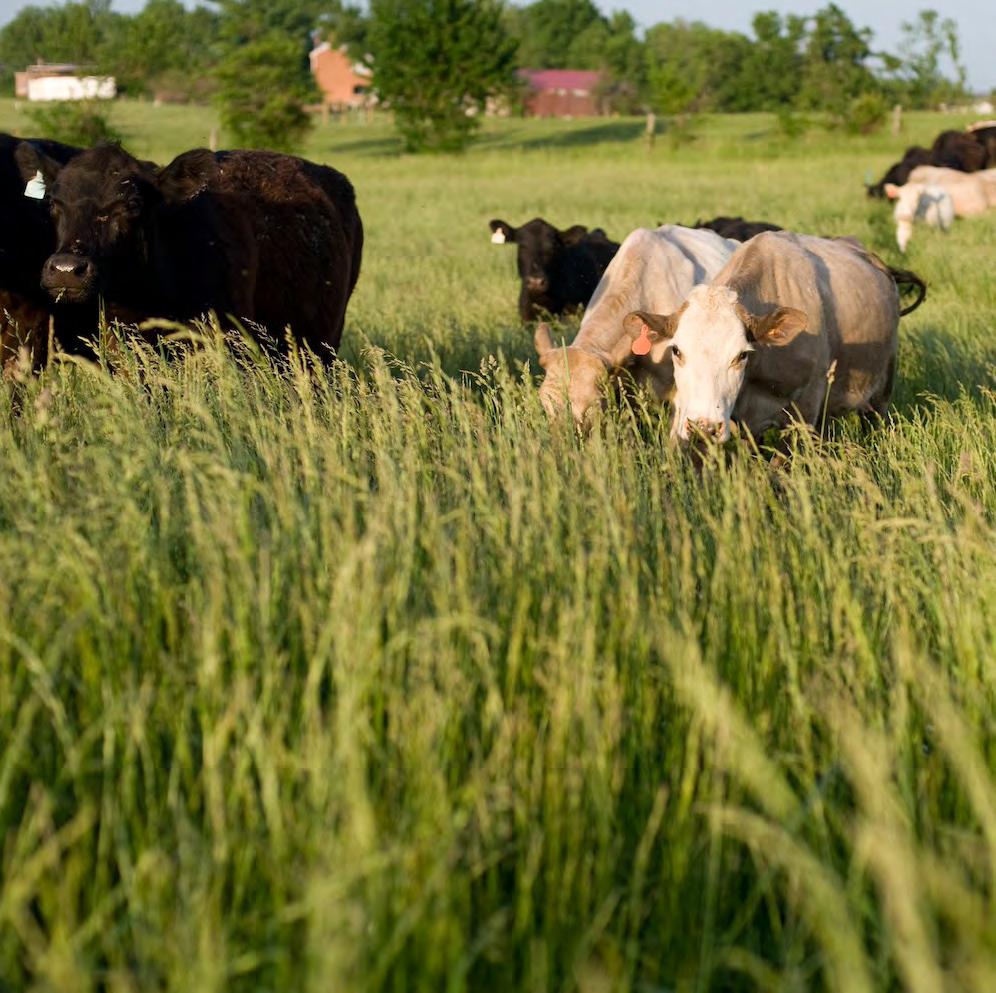
Processing around 70 cattle a day, four days a week, and pigs and lambs on the fifth day, Marksbury is small enough to carefully handle each animal and provide artisan-level butchering quality, while large enough to meet the volume requirements of major clients. Lot sizes are small, consisting of 12-50 animals, and a designated ID number used throughout the process provides traceability.
Marksbury’s values guide their relationships with their processing clients. The day of the tour, the staff was packaging for Hickory Nut Gap
Meats from North Carolina and Grayson Natural Farms in Virginia. The business works with similarly focused brands from Georgia and Tennessee. Many clients are mailorder companies, which have seen tremendous growth in the last four years.
The COVID-19 pandemic and its aftermath moved the needle for many local food businesses. When centrally located processing facilities and long supply chains faltered, people realized the precariousness of the industrial food system. With its nearby location and short supply
chain, Marksbury was able to fill some of the gaps in Central Kentucky. For example, Kroger was already selling Marksbury products in the natural food section. When the grocery store chain had a shortage from its other suppliers, it reached out to Marksbury for a much larger order of ground beef. Working with its cadre of local farmers, the company delivered the order within the week.
“When the big system broke down, people realized our business was actually legitimate,” Swaim said. “The crisis validated the viability and
18 KENTUCKY MONTHLY MAY 2024


necessity of small-scale food systems, and much of that new business has stuck around.”
A Taste of the Bluegrass
Marksbury meats can be enjoyed in area restaurants or purchased for cooking at home. A small fast-casual lunch restaurant named Pasture serves up its high-quality meat on site. The limited menu includes a hamburger, chorizo burger, brisket sandwich, pulled chicken sandwich and a lettuce salad. Daily specials— such as beef quesadillas, chorizo mac and cheese, and pork tenderloin with garlic cheese mashed potatoes—are posted weekly on social media.
The industrial-feel Pasture is open Monday-Friday from 11 a.m.-4 p.m. Diners often rub shoulders with Marksbury staff members enjoying a meal break. A retail section sells frozen meats and other local, artisanal products such as milk and honey.
In nearby Stanford, two restaurants serve Marksbury meat exclusively. Mama DeVechio’s Pizzeria tops its pies with the local Italian sausage, ground beef and ham. The Bluebird serves seven types of burgers, a creamy Cajun pasta with Andouille sausage, and steak and pork chop entrées.
For wholesale orders, Marksbury works with distributor What Chefs Want (formerly Creation Gardens), which reaches food businesses from Indianapolis to Birmingham and from St. Louis to Asheville. Consumers can find Marksbury products at Lexington’s Good Foods Co-op and many area Kroger stores and Whole Foods Markets.
While Marksbury is primarily a processing and wholesale company, it also offers a small online shop for nationwide shipping or local 24-hour pickup. Shoppers can choose from packages and cases, pre-selected boxes or the option of a monthly subscription. Q



kentuckymonthly.com 19
Celebrating Duncan Hines
BY JACK BRAMMER
Bowling Green will host a weeklong festival to honor the native son who modernized American dining



20 KENTUCKY MONTHLY MAY 2024

Believe it or not, the distinguished-looking man with the warm smile and wet shorts and shirt perched precariously on a board over a tank of water last June in downtown Bowling Green was Duncan Hines
No, not the Duncan Hines who in the mid-20th centur y was an American author, food critic known for his restaurant ratings for travelers, and food products developer—most famously of cake mixes.
The man hovering over the water tank was a distant cousin of Hines who has the same name. This Duncan fell into the water when someone threw a ball that hit the right spot, triggering the board to collapse.
The free, popular game called “Dunk Duncan Hines” was a part of the first Duncan Hines Days last year in Bowling Green and the surrounding area. The weeklong event attracted at least 16,000 people from 28 states, based on zip codes tracked. It generated a conservative economic impact of $2.28 million for the area.
The second annual Duncan Hines Days is to unfold June 3-9, and preparations are under way, said Telia Butler, Bowling Green’s downtown development coordinator. Butler is a Bowling Green native who has held her job for about 2 ½ years and is a Western Kentucky University graduate. She formerly worked for the Bowling Green Convention and Visitors Bureau and the Bowling Green Marriott Hotel.
“It’s a grand community event— mostly free,” Butler said in her best promotions voice. She said Bowling Green observed Duncan Hines festivals in the early 1990s and 2000s on a smaller scale. “We decided to do much more and ended up with 20 events last year and have about the same number for this year.”
One of this year’s highlights will be the Eats & Beats Music Fest on June 8 from 3-10 p.m. at Circus Square Park. It will feature Bowling Green native Sam Bush, an American mandolinist who is considered an originator of the progressive bluegrass music known as “newgrass.”
Various events are scheduled for each day to honor the cake mix king.
Who Was Duncan Hines?
Born in Bowling Green on March 26, 1880, Duncan Hines was the son of a former Confederate soldier. When he was 4, his mother died, and he was raised by his grandmother. He attended Bowling Green Business University, which later merged with the current Western Kentucky University.
Hines worked for Wells Fargo in the American West and other companies before settling in Chicago.
As a traveling salesman in the 1930s, he ate many meals on the road across the United States. Hines and his wife, Florence, compiled a list of good restaurants to visit, which evolved into his first book, Adventures in Good Eating, which became a success. A few years later, he published the book Lodging for a Night. Both books were excellent for travelers. He followed these up with cookbooks, including Adventures in
kentuckymonthly.com 21

Good Cooking and the Art of Carving in the Home, The Duncan Hines Barbecue Cook Book and The Duncan Hines Dessert Book He also wrote a column about food that was syndicated in several newspapers.
In 1952, Hines introduced Duncan Hines bread through a bakery in New York. He later came up with cake mixes. Five years later, Procter & Gamble bought the cake mix business.
Hines died of lung cancer at his Bowling Green home on March 1, 1959, at the age of 78. He was buried in the city’s Fairview Cemetery.
Conagra Brands, the current name for Nebraska Consolidated Mills, now owns the Duncan Hines brand. In 2022, it put out a mix named in honor of country music singer Dolly Parton. Natasha Neely, billed as Nashville’s No. 1 Dolly Parton impersonator, performed at last year’s Duncan Hines Days. She is scheduled to be back this year at the ice cream social.
Louis Hatchett, author of the 2001 biography Duncan Hines: The Man Behind
the Cake Mix, said Hines without a doubt is one of the most recognizable names in American food products. “While other guidebooks of the era, like The Jewish Vacation Guide and The Negro Motorist Green Book, were providing safe travel tips for minorities fearing for their safety in small towns,” Hatchett wrote, “Hines was providing reassurance for motorists concerned about the growing number of deaths attributed to poor health standards at roadside diners.”
Hines’ influence on American dining standards is unparalleled. While traveling the byways and highways of a newly motorized nation in the 1930s, Hines was impressed by many dining establishments … and shocked by others.
At a time when there were no health departments, Hines was not afraid to ask to see the kitchen as he anonymously inspected a restaurant. His humble, yet humorous, opinions became the basis for his guidebooks
that soon were in nearly every glove box in the nation.
Hines’ name on foods represented excellence in quality then and now, said Hatchett. “He gave us much more than some wonderful products for the kitchen,” Hatchett said. “He gave us a higher standard of dining in America.
“The next time you have an exceptional meal while dining out, give him a little nod.”
Bowling Green has honored Hines in various ways. A portion of U.S. Route 31W north of the city was named in his honor after his death in 1959. WKU’s Kentucky Museum in Bowling Green has an exhibit that showcases Hines’ life. A historical marker stands in front of the structure that Hines built in 1940 as his home and office at 3098 Louisville Road (U.S. 31W) and today is Hardy and Son Funeral Home.
The upcoming Duncan Hines Days is yet another way for Bowling Green to honor one of its most famous native sons.
22 KENTUCKY MONTHLY MAY 2024


The Celebration
The downtown kickoff will be held June 7, starting at 3 p.m. with a vintage car show around Fountain Square. A summer stroll parade is on tap at 4 p.m. and a community ice cream social will run from 5-8 p.m., with free live music and a party presented by Bourbon & Brewfest at BG Hot Rods Ballpark Plaza.
VIP tickets for the June 8 Eats & Beats Festival are for sale online for $75 each. The fest will offer food trucks, drinks and merchandise. WKU will provide additional parking on campus with a shuttle to and from the festivities.
More than 5,000 people attended the music festival last year, when the Kentucky Headhunters and Government Cheese were the featured musical acts.
Picnic Pops is scheduled for June 9 from 2-5 p.m. at Riverview at Hobson Grove. Admission is free to hear Orchestra Kentucky’s big band play live music on the historic
grounds. Feel free to bring your own picnic basket.
Throughout the week, Bowling Green will highlight its inaugural Restaurant Week, presented by Tyson Foods.
About 30 sponsors support Duncan Hines Days, Butler said. Each provides around $80,000 for the events, with government sponsors chipping in about $20,000 each.
At least 200 people are needed to bring it to fruition. “And by time they have been here, they will know more about Duncan Hines,” Butler said.
“He was a real man,” Butler said. “Other food name images, like Betty Crocker, were not real. Duncan Hines was real.”
Today’s Duncan Hines, who is expected to be back in the dunking booth at the festival, said he never met his famous cousin, but “the family is excited that the community is honoring him.
“How can you not love a guy who is responsible for so many cakes?” Q

If you go...
A detailed list of the Duncan Hines Days events can be found at duncanhinesdays. com They include a nostalgic block party, a water park day and a pickle ball social.
kentuckymonthly.com 23
For a Louisville mother and daughter, a traditional family treat evolved into a popular pickle product
a Big Dill
BY JACKIE HOLLENKAMP BENTLEY
24 KENTUCKY MONTHLY MAY 2024

Historians believe the first cucumbers were pickled more than 4,000 years ago, that Cleopatra ate pickles as part of her beauty regimen, and Christopher Columbus rationed pickles to his sailors.
Fast forward to a mid-20th century Kentucky home, where Polly Whitehouse took a regular dill pickle and made something special for her family and friends. In 2018, Whitehouse’s daughter and granddaughter launched Polly’s Pickles, which soon would become a bustling business.

Polly’s Pickles Past
Like many family-owned culinary businesses, it began with a homemade recipe. Whitehouse took a jar of dill pickles, marinated them and then served them as an unlikely side dish for big dinners.
“She only had them on special occasions like Christmas and Easter, and it was just a big treat,” her daughter, Karen Larimore, said. “I have happy memories of childhood sitting around our dining room table … and at the end of the meal, we would pass these around. And that’s


where a lot of family history and stories were told and where you learned who you were in the family. So, I connect that with the pickles.”
Larimore’s daughter, Polly Reynolds, has fond memories of her namesake.
“Obviously, my memories are a little different, but [they] did revolve around the table,” Reynolds said. “I remember that when my grandmother did make [the pickles], she would make them in these big jars. I didn’t even know anything about it; I just knew that whatever was in that big jar turned into

something really good.”
That big jar contained Whitehouse’s marinade, in which the pickles rested for five days and later chilled in the refrigerator. Larimore and Reynolds stick to that same recipe and process when making Polly’s Pickles.
“You start with dill pickles, and you slice them, and you marinate them,” Larimore said. “People ask us if it is a dill, and yes, it is a dill, but the dill has been changed. Our recipe is sweet and savory. It’s not exactly like a bread-and-butter pickle, either. Those are sweeter than ours. We have
kentuckymonthly.com 25
Above left, Karen Larimore and Polly Reynolds; below, Polly Whitehouse through the years.

garlic in the marinade. We have bay leaves in the marinade … It’s a totally unique kind of taste. And as far as we know now, nobody has that same type of pickle out there.”
Back in Polly Whitehouse’s day, they were just a special dinner dish. For a few lucky teachers, family and friends, they also were treasured gifts from a woman who Larimore said epitomized hospitality.
When Whitehouse died in 1990, those same friends and family members asked Larimore and Reynolds if the pair could make them a batch or two or 10.
“They would ask for eight to 10 jars at a time,” Larimore said. “We didn’t have the jars. We didn’t have a label, and we were thinking, ‘Well, gee, this might be a business.’ ”
At the time, Larimore was an elementary school principal, and


Reynolds was a nursing educator. It was natural that the duo wanted to educate themselves before launching a new venture—what it took to get certified by the Commonwealth of Kentucky, and, more importantly to them, gain certification as a Kentucky Proud product.
“We wanted to get certified from the beginning,” Larimore said. “We felt like our business would be so much better if we had the state come in to look at what we’re doing and approve what we’re doing. We didn’t even start until we had all that behind us.”
Once that was done, a Kentucky Proud label soon followed, and Polly’s Pickles popped up on shelves at Paul’s Markets in Louisville. Larimore and Reynolds set up tasting tables at the stores, promising shoppers that if they tried
just one pickle, they would be hooked. And most were.
Then the COVID-19 pandemic hit. Sales slowed but not for the usual reasons most businesses suffered during that time.
“It seemed like there was more demand than there was a supply for us, which is the opposite of what you normally saw,” Reynolds said. “But at that time, people were cooking more at home, and people were experimenting more with different things at home. So that really helped us out.”
Despite facing inventory shortages on pickles and jars, Larimore said the community support saved them.
“There are people who want to help you out and want to use local,” she said. “They looked us up and supported us. That’s another reason why we’ve survived.”
26 KENTUCKY MONTHLY MAY 2024
more information about
visit pollyspickles.com.
For
Polly’s Pickles,
Karen in the kitchen
Polly’s Pickles Present
In addition to Paul’s Markets, Polly’s Pickles can be found at several meat markets in the Louisville area as well as local farmers markets, arts and crafts festivals, and holiday bazaars not only in Kentucky but in North Carolina and South Carolina.
While Polly’s Pickles has yet to become a large-scale operation,
Reynolds said they stay busy since their pickles must be made on demand because they’re not shelf stable.
Larimore, who has since retired from full-time work as an educator, said the timing can be tricky.
“We have to make sure we don’t have too many, but we need just about enough, and we’ve gotten a feel for that,” Larimore said. “We know when people want them.”
The mother-daughter duo also learned more about each other in navigating the ups and downs of starting a family business.
“At times, [Polly] would get discouraged, and I’d say, ‘No, we’re going to keep at it.’ Then I would get discouraged, and she would say, ‘No, we’re gonna keep going,’ ” Larimore said. “It was a whole new world for us. We had no business background. None. It was just a different language, different types of people that you run into. But we both love it. We both love learning business. When I look back at how we started, we were so green. We learned together.”
Reynolds said they’re still learning and looking to expand the product line, while keeping true to her grandmother’s legacy.

“For the past couple of years, there’s been an explosion of pickles— whether it’s pickle popcorn or pickle potato chips and people using dill pickle juice in mixed drinks,” Reynolds said. “There’s just all these different aspects of what you can do with a pickle. It’s not just a sidelined vegetable anymore. It’s a part of the act, and we’d like to take advantage of that and see what our pickle can do to enhance … not just the having a little pickle on the side of your plate, but as a part of your meal and being a player in the game instead of sitting on the sidelines.”
“We’re constantly experimenting, and things are moving along,” Larimore said. “Thank goodness the world loves pickles.” Q

kentuckymonthly.com 27
For the Love of the Horse
Midway University’s Equine Studies program marks 50 years of hands-on learning to prepare students for horse industry careers
BY KRISTY ROBINSON HORINE
28 KENTUCKY MONTHLY MAY 2024

On top of a gently rolling hill in Woodford County, a horse named Chicken stands in the Spy Coast Farm Education Center classroom in Bud’s Barn. A student runs her hand along the horse’s muscled shoulder, down the cannon bone, and back to the fetlock. A gentle squeeze from the student, and Chicken raises a hoof for inspection.
Across campus, on the far side of the railroad tracks near the Ashland Stable, a few more students make their rounds with M&M and Velvet.
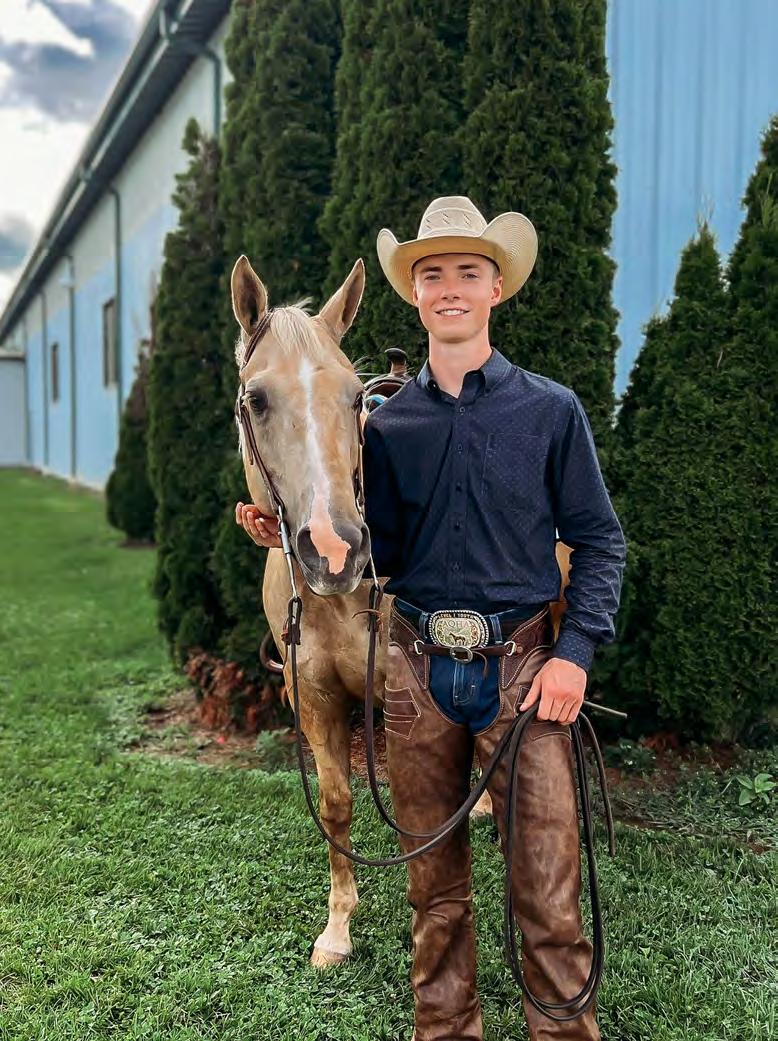
This is but a glimpse of the life and learning of typical Midway University Equine Program students.
Through the course of a semester, Equine Program students gain valuable hands-on training with horses bearing names like Chicken, Snickers and Flint. They are part of a 34-horse herd that lives, works and—yes—teaches on Midway University’s 160-acre equine farm. What is begun here, on top of this hill, is practically applied out there, in the wonderful and diverse world of the horse.
TRAINING FUTURE LEADERS
“There are horses everywhere,” said Mark Gill, dean of the Equine Program. “One of our goals is we want to continue to contribute to and strengthen what’s really a signature industry of Kentucky. So, we look for our students to be the future leaders of that effort, and you’re seeing the fruit of that now.”
At most liberal arts colleges and universities, students spend the first two years completing general education requirements before moving into classes that focus on
their chosen majors. At Midway, students are immersed in their majors right out of the gate. Freshmen take a wide survey class introducing them to every aspect of the equine industry. They also are required to take equine anatomy and physiology.
“We want them to be well versed and understand the structure of a horse,” Gill explained. He pointed out the detailed diagrams painted on the concrete walls of the Equine Center’s Indoor Arena. “They are able to talk intelligently about the unique aspects of everything equine.”
As far as the hands-on element, the answer is simple: chores. Freshmen are in the barn at 7 a.m. and 3 p.m. every single day, cleaning, grooming and learning as they go.
“If you don’t love that part of your day, then there’s probably a different pathway we want to take toward helping you find your career,” Gill said. “When it’s 5 degrees, you’re still out there taking care of them because horses need to be fed. They need to be watered. They need to be cared for every day.”
The university farm is referred to as a “living laboratory,” where students learn to manage everything
kentuckymonthly.com 29
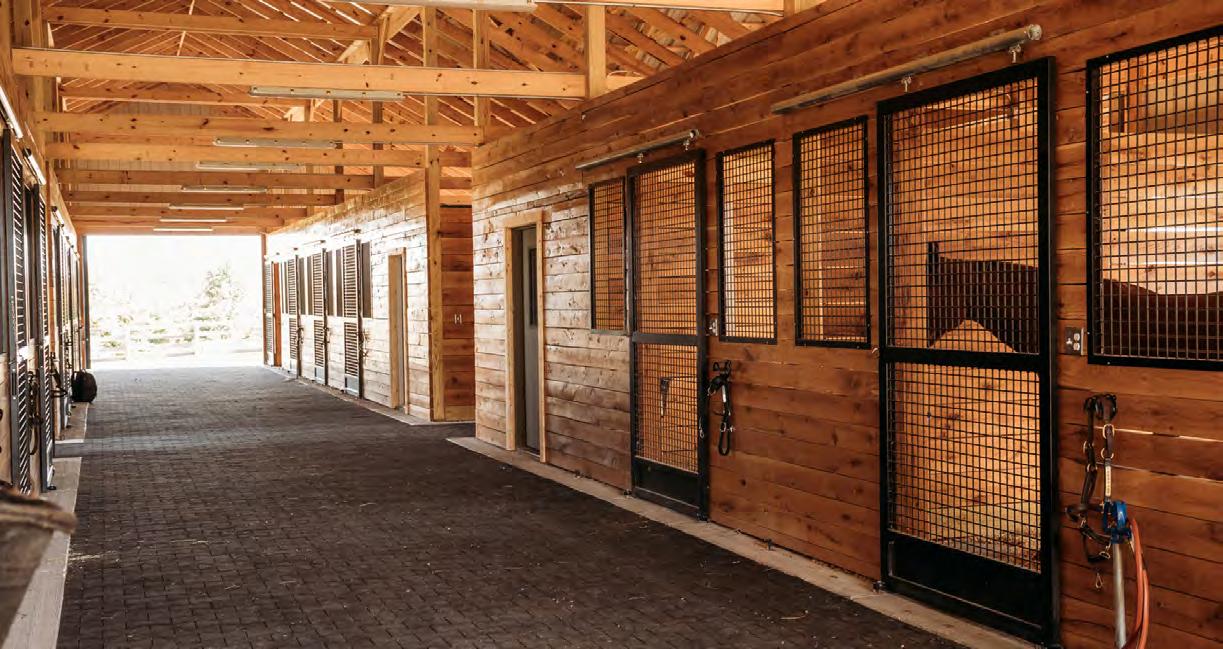

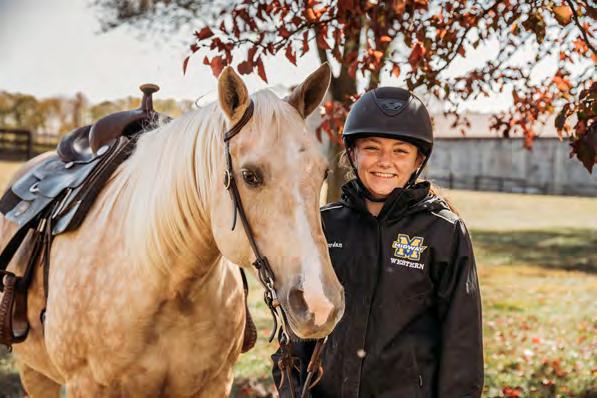
from mucking stalls to backing a six-horse trailer with precision. Classroom work includes subjects such as science, the fine art of equine syndication, and the mechanics of rehabilitation.
It’s this academic and practical work ethic that has separated Midway University’s program from most other equine programs in the United States.
The program’s success stems partly from the university’s rich heritage of meeting needs.
A HISTORY OF CLOSING THE GAP
The school was founded in 1847 by Dr. Lewis L. Pinkerton to educate young, orphaned women. Midway became fully co-educational in 2016.
Over time, the institution adapted its programs to meet the needs of the day. The Equine Program began in 1974 to educate women in administrative functions of the industry. As the equine world in Kentucky and beyond matured, so did Midway’s program.
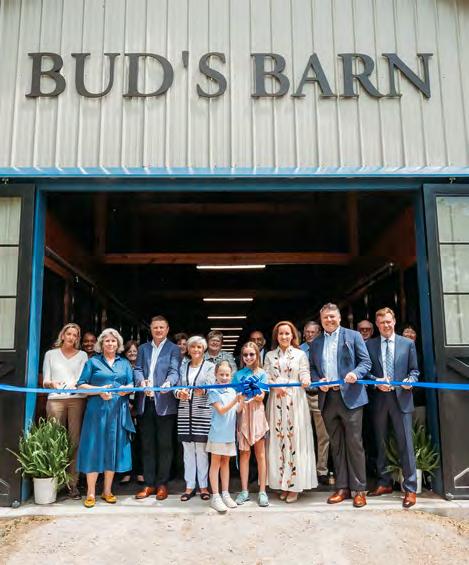
The university currently offers undergraduate Equine Studies degrees with four different concentrations: management, rehabilitation, science, and business and sales, as well as an MBA in equine management. Student athletes can compete on the award-winning equestrian team in western and hunt seat disciplines. Because Midway is located in the heart of equine heaven, opportunities abound for internships at nearby farms and equine organizations.
The university works hard to establish and maintain connections within the industry. About five years ago, it formed an Equine Advisory Council made up of professionals from all aspects of the industry to best serve the business and equip its students.
“We wanted to get a wide variety of input across the industry as to how we can best prepare our students for careers in their fields,” Gill said. “We are aware of the jobs and the needs, so that connection is really helpful in keeping our program always future-looking.”
30 KENTUCKY MONTHLY MAY 2024

MISSION ACCOMPLISHED
Jennifer Day came to Midway University from Taylor, Texas. She knows a little something about horses. “I began riding at a horse camp at age 7 and never looked back,” she said.
Day has spent more than 20 years in the hunter jumper discipline and competes with her horse, Mister Wright. She participated as a student athlete on the equestrian team and was privileged to ride rare breeds such as the Akhal-Teke, the American Cream Draft and the Marwari while working at the Kentucky Horse Park.
Day earned her bachelor’s degree in science in equine health and rehabilitation (2017) and her master’s in business administration (’20) at Midway. Her deep love for the horse, coupled with Midway’s practical education model and its industry contacts, made for a perfect combination that led to her dream career. She works for the United States Equestrian Federation in the National Breeds and Disciplines Department. Day manages the responsibilities of planning and executing national championship events for hunters and equitation at the Federation.
“Midway offers a unique experience for equine students in that the farm is on campus. What’s better than walking out of your dorm and seeing the horses? The equine programs at Midway are hands-on and allowed me and my fellow classmates to learn in an interactive and positive environment,” Day said.
According to an internal survey, the Federation has employed more than 30 former Midway Equine Program students. That’s an impressive track record.
“It’s not just knowing we’re preparing students to go out and be hands-on with horses. They’re also working in the administrative events of the industry and providing leadership there as well,” Gill said. “Every type of job you can think of in the equine industry, you probably have a Midway alumnus that’s working somewhere out there right now.”
The last 50 years of investment will hopefully lead to the next 50 years of success. Whether in a classroom, an office, a pasture or a barn, Midway University’s Equine Program will gallop forward, the best in breed, into the wonderful world of the horse. Q


kentuckymonthly.com 31
PAYING RESPECT
Henderson’s moving Memorial Day service is the work of a small army of volunteers from all walks of life
BY CHUCK STINNETT
Every May in Henderson, men, women and children can be seen roaming the city’s Central Park—some searching, some carrying flowers, most carrying memories of departed loved ones.
They walk among dozens of rows of white crosses, more than 6,000 of them, each bearing the name of a Henderson County resident who served our country in the military and has since died, some in combat and many in the years after their military service.
It is a generations-old tradition in this Western Kentucky city on the Ohio River. Local lore, passed down by the late James E. “Snoz” Davis—a World War II and Korean War Army veteran and longtime member of the American Legion Worsham Post 40’s color guard—was that just a dozen crosses were erected at the first Memorial Day service in Henderson.
The earliest newspaper account unearthed by Henderson Gleaner history columnist Frank Boyett came from 1935, announcing the American
Legion’s plans for a tribute on Decoration Day, before “Memorial Day” became the generally accepted term for that day of remembrance in late May. That service in Central Park included an unspecified number of crosses with the names of Henderson servicemen killed during World War I.
Boyett also located press accounts of the Legion’s Decoration Day service in 1941 for which white crosses were to be erected for each WWI veteran killed in service as well as a large cross to represent those who died in other conflicts, including the American Revolution, Civil War and Spanish-American War. The Legion organized a similar service in 1942, but the observances reportedly ceased for the duration of the Second World War.
Then in 1945, the Memorial Day service was revived. Two bands led the largest parade in Henderson in years to Central Park. There, 286 white crosses, “one for each of Henderson County’s war dead who died in World War I and II and those veterans who have passed away since
World War I,” had been erected. A former Army infantry lieutenant, who had been honorably discharged because of combat wounds, delivered the principal address. A squad of riflemen fired a volley, Taps were played, and a benediction was said. Following that, the crosses were decorated with flags. The entire service was broadcast on WSON-AM, the local radio station.
With that, the display of white crosses in Henderson’s Central Park for Memorial Day became a beloved annual tradition.
• • •
Over most of that history, the crosses were wooden and handmade. “I started in 1962 when I was 11 years old,” Snoz Davis’ son Tom recalled. The youngster used a stencil to help paint the names of deceased veterans on crosses in the basement of the local Legion hall.
“I used to make them in my shop class” at South Middle School, recalled Col. Jim Smith (U.S. Army, Retired), who served as a helicopter pilot
32 KENTUCKY MONTHLY MAY 2024

during the Vietnam War. In those days, he noted, “They took a sledge and hammered them in the ground. After two years, they’d be frayed, and we’d have to make new ones.”
Over time, members of the American Legion Worsham Post aged, and the organization’s funds ran short. Around 1995, the Henderson Veterans Memorial Foundation “stepped in and said, ‘We’ll pay for it,’ ” said Ken Christopher, who served as a sergeant in Vietnam and has been active with the foundation and the Memorial Day service for many years.
One day around 2000, Jim Hanley—who became a Marine in 1967 and served in Vietnam in 1969— dropped by the American Legion hall. “I was sitting in here and heard a guy [who had been involved in erecting the thousands of crosses each May] say, ‘I’ve had enough. I quit,’ ” Hanley said. “It kind of hit me—why give that up? So, I got involved.” Hanley has been leading the cross program ever since.
Meanwhile, the issue of having to
replace wooden crosses every year or two continued. “My dad was a World War II Navy veteran,” Hendersonian Dave Morris said. “He’d take us down to the memorial. In 2003, we watched them set up. They were breaking more than they were getting in the ground. Dad said, ‘Isn’t there something you can do to help?’ ”
There was. Dave and his brother, Richard, ran Morris Tool & Plastic Inc. in Henderson. “Over the next year, we brainstormed,” Dave said. and eventually, they settled on molding two-piece plastic injectionmolded crosses that could be glued together. Thanks to donations of labor and materials by Morris Tool and others, more than 3,000 crosses were given to the American Legion at no cost in 2006, with additional crosses manufactured each year for newly deceased veterans. The crosses stand 32 inches tall and are 16 inches wide, with a hole on top to accommodate a small American flag on a wooden pole. The name of a deceased veteran in black letters is applied to each cross through a vinyl transfer by a
local company called Sign Design.
“My only regret is that Dad didn’t live to see it come to fruition,” Dave said.
Initially, steel stakes were driven into the ground and a cross affixed to each stake. Then in about 2010, Morris Tool produced plastic bases with nail prongs that could be pressed easily into the ground to hold each cross upright.
The logistics of storing, laying out and erecting crosses each year is planned like a military campaign, and it takes a small army to carry it out. “It’s not a one-man show,” Morris said.
The crosses are stored in a pair of semi-trailers donated by a local chemical distributor. They are placed in alphabetical order inside the trailers on racks made from donated steel electrical conduit or angle iron.
Each spring, women from a local addiction recovery center carefully clean each cross and add new crosses to the mix. A Henderson trucking company moves the semi-trailers into place beside Central Park. American
kentuckymonthly.com 33

Legion members Bob Skaggs and George Tillotson lay out a grid for placing the crosses three feet apart. The women from the recovery center place the bases into the ground, and several local restaurants donate coffee, doughnuts and meals to feed the workers.
A fork truck unloads racks of crosses from the trailers, and students from North Middle School are bused over to insert the crosses into the bases while double-checking that they are in alphabetical order. “It takes two days, if the weather’s good,” Hanley said. The crosses go up about three weeks before Memorial Day and stay up until a week after.
Members of the Ladies Auxiliary of the American Legion affix a small flag to the top of each cross.
This year, for the first time, the Traveling Kentucky Vietnam Memorial Wall will come to Henderson May 25-27. It bears the names of more than 1,100 Kentuckians killed in action during the Vietnam War, held as prisoners of war, or still missing in action.


More Foundation Contributions
Aside from organizing the Memorial Day observance, the Henderson Veterans Memorial Foundation also has raised hundreds of thousands of dollars to erect monuments in two city parks to honor veterans and commission a life-size statue of Adm. Husband Kimmel, a Henderson native who commanded the U.S. Pacific Fleet when the Japanese attacked Pearl Harbor on Dec. 7, 1941.
Foundation members and many Hendersonians think Kimmel was made a scapegoat. They’ve tried to clear his name and have his rank posthumously restored to a four-star admiral.
On the morning of each Memorial Day, the Henderson Veterans
Memorial Foundation presents a formal program. A typical program includes prayers, the Missing Man Table and Ceremony, presentation of colors, the National Anthem and Pledge of Allegiance, wreath placements for each branch of service, a featured guest speaker, patriotic music, a rifle salute and the playing of Taps.
The ceremony incorporates a broad swath of participants: the American Legion Post 40 Honor Guard, the local high school’s band and Army Junior ROTC, members of the Veterans Memorial Foundation, a Shriners’ Legion of Honor, representatives of each branch of the military, a pastor and more.
On May 27, the keynote speaker will be Sarah Taylor, past president of the American Gold Star Mothers Inc., whose son, Army Specialist David Taylor, 82nd Airborne, was killed in Kandahar, Afghanistan, on March 29, 2012.
“What a wonderful opportunity it is for the community and the whole tri-state to come here and see such a beautiful memorial, and, if they have someone [memorialized with a cross], to go see their name,” Taylor said. “And teach children about honor and respect and sacrifice and what
Memorial Day is all about.”
“We have a lot of people come to the program downtown,” Smith said. “We don’t have chairs for them all. They bring their own chairs.
“I think this community is a patriotic community. They appreciate this.”
After Memorial Day, the crosses are taken down as carefully as they were put up. Members of the Henderson County High School boys soccer team remove the crosses in alphabetical order and return them to their racks, while women from the recovery center retrieve the plastic bases. They are all stowed away carefully for next year.
Veterans Memorial Foundation members, who include several veterans, suspect that a few World War II veterans from Henderson, undoubtedly around age 100, are still alive. But they note that the number of living veterans from the Korean War and even the Vietnam War is declining. Each year, more crosses go up.
“This town loves its veterans,” Hanley, the Legion’s cross organizer, said.
And though he’s now 77, he said, “I’ll keep doing it as long as I can.” Q
34 KENTUCKY MONTHLY MAY 2024
• • •






Nestled in Western Kentucky, Moffit Lake Recreational Area is a 140-acre county owned and operated campground which lies in a beautiful natural setting. The lake is the heart of the campground that provides pristine waterfront campsites and cabin rentals. The perfect place to enjoy a picnic or family outing. And, don’t forget to bring your poles because the fishing is great! unioncountyky.org | 270.333.4845 378 Moffit Lake Road, Morganfield, KY 42437
CAMP FISHHIKE PADDLEENJOY

The Past Is Present
The Filson Historical Society remains true to its mission of preserving and sharing Kentucky history while expanding its reach
BY DEBORAH KOHL KREMER
36 KENTUCKY MONTHLY MAY 2024
Many years ago, a group of men in Louisville met regularly to share their historical research on Kentucky and the Ohio Valley.
Although they knew the collaboration was valuable, little did they know that their gathering would grow to become The Filson Historical Society, which is celebrating its 140th year.
Many things have changed in that time. But Dr. Patrick Lewis, director of collections and research, said the mission has changed very little. “The way we live that mission and who we include in that mission have changed a great deal,” he said. “But fundamentally, the basics of research, publications and gathering to hear lectures on Kentucky history—that has remained absolutely consistent for 140 years.”
The original group of 10, which included the primary founder and first president Col. Reuben T. Durrett, called themselves The Filson Club, which was a nod to early explorer and pioneer John Filson. In 1784, Filson published the first book about what would become the Bluegrass State, The Discovery, Settlement and Present State of Kentucke, as well as the first map of Kentucky.
The Filson is headquartered in the 20,000-square-foot Ferguson Mansion on Louisville’s South 3rd Street, which dates to 1905. This beautiful example of Beaux Arts architecture is among other palatial estates in the Old Louisville neighborhood. Also on the property is the modern Owsley Brown II History Center, which houses exhibit galleries, library space and event venues.
The organization has a massive collection of historical items, including diaries, photos, early maps, books and newspapers. There is no definitive way to list them in order of value or status, but it seems everyone finds something that strikes a chord.
Richard Clay, who has been president and CEO for six years, has several favorites in the collection. Among those are paintings by Aaron Corwine (1802-1830), an artist from Maysville. “Corwine died at age 28, and so he didn’t turn out the volume that Matthew Harris Jouett, Oliver Frazer or Joseph Henry Bush did, but Corwine is of equal importance and value,” Clay said. “These works are really magnificent.”
The Filson is home to handwritten letters, some of which explain everyday life and others that contain historically significant details. Clay said he is moved by the letters that The Filson has from William Clark, of the Lewis and Clark Expedition, to his brother Jonathan Clark. Jonathan stayed in Louisville and in these letters, William relates the story of the expedition.
Dr. Lewis, who will step into the role of president of The Filson upon Clay’s retirement at the end of this year,
has some favorites in the collection, too. Among those are the historical family portraits and a pair of manumission papers that a formerly enslaved couple carried with them to prove they were freed.
Not everything at the organization is old. Lewis explained that, to stay relevant moving forward, things that will be historical eventually must be collected now.
One such item currently on display is a portrait on a piece of plywood that covered the windows of a downtown Louisville business during the protests of 2020. It was on this piece of wood that artist Red Biddix painted a Black woman with a poem written around her. The poem is about the summer of 2020, social justice, violence and race.
“That is our reminder to ourselves, and everybody researching, that history doesn’t stop. It is not all in the past. We are living in a historical moment. Everything we do is influenced by everything that happens in the world around us,” Lewis said. “One day, that piece is going to be one of the most important historical items that we were able to collect in the last few years.”
The organization also has given back items to ensure they belong to their rightful owners, as is the case with their Native American collection.
“We worked closely with tribes that were in Kentucky and the Ohio River Valley, including Choctaw and Cherokee, and we have repatriated everything in our collection that we should’ve never held. It is very important work,” Clay said. “We have also led other Kentucky institutions in helping them repatriate their materials.”
The club originally was made up only of white men. Clay is proud to say that the organization today has a fully diverse board, diverse staff and diverse programming, along with a $2.5 million Jewish archive and a $3.4 million African American history initiative.
Access to the collection is within reach of anyone with a computer. Printed materials—such as newspapers, journals, diaries and letters—are digitized, and almost every lecture and program, about 100 per year, is recorded on The Filson Society’s YouTube channel.
Lewis intends to ensure that future generations are familiar with The Filson, with programs that invite multiple generations and show people how everyday stories of families like theirs are historically valuable and interesting. The Filson continues to empower by teaching research techniques and encouraging visitors to share their findings.
“In the earliest days of The Filson, all of the members were active researchers and writers. You didn’t come to passively sit in the room and listen,” Lewis said. “You
kentuckymonthly.com 37
• • •
• • •
Filson 140: A Heritage Jubilee
The Filson Historical Society has planned events throughout the year to celebrate this milestone anniversary. The largest gathering is the family-friendly party on May 18. Guests can tour the mansion and view exhibits while enjoying live music by Appalatin and the Louisville Leopard Percussionists. The Louisville Slugger company, which also celebrates its 140th anniversary, will be on hand with bat-making demonstrations. Guests can enjoy games, treats and the fun of Springfest, the annual festival in Old Louisville’s nearby Toonerville Trolley Park that will be going on at the same time.
“We want to expose more people to the services we have, and this will be a fun way to do it,” said Julie James, vice president of The Filson.
Here is a selection of the anniversary events scheduled for the rest of the year.
June 13 The Filson Historical Society will present a 20-minute program with snacks prior to Shakespeare in the Park’s presentation of Romeo and Juliet, and a pre-show in Central Park with self-guided maps and an introduction to the play
June 17 Theodore Sedgwick Distinguished Lecture Series
July 12 Filson Friday program — Flowing Stories of the Ohio River and Its People: The Filson Historical Society and an expedition on the Belle of Louisville
Aug. 8 Music Under the Trees with The Crashers at Oxmoor Farm
Sept. 8 Jazz at The Filson
Sept. 10 St. James Court Art Show Poster Unveiling Press Conference
Sept. 13 Harlan Hubbard exhibit opening
Oct. 18 Filson Sporting Clay Classic
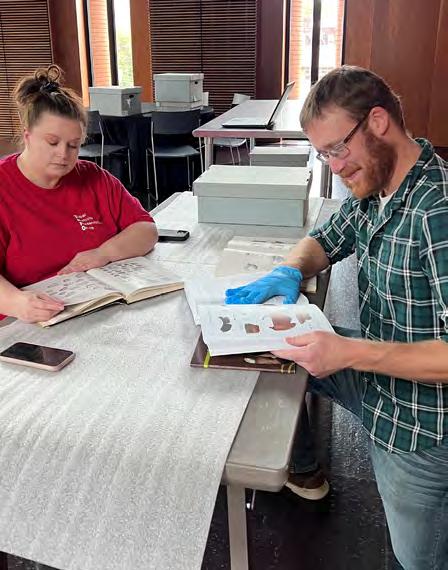


Top photos, The Filson Historical Society has an large collection of artifacts, including diaries, photos, early maps, books and newspapers, many of which are available to researchers; above, behind the Ferguson Mansion is the contemporary Owsley Brown II History Center, which houses exhibit galleries, library space and event venues.
came to share library resources, you came to share your ideas or a work you were drafting, and you hoped to get published and feedback. Everybody was an active participant.”
Clay believes The Filson has the deepest collection of Kentucky historical materials in the nation, which benefits not only historians and researchers but our democracy.
Information on further events and activities can be found at filsonhistorical.org/events/ upcoming-events
“The more you know about history, the more you understand basic civics, the better off all of us will be,” he said. “You have to understand it and see it in context throughout its history. And once you do that, you’re in a much stronger position to look at the good and the bad in American history and strive to make it a stronger, better, more cohesive union.” Q
38 KENTUCKY MONTHLY MAY 2024
For tickets and other information, visit


In Kentucky, Valhalla is the Louisville golf course that will host the PGA Championship, May 13-19.
Heading the lineup is Scottie Scheffler, who in April won the Green Jacket as the Masters Tournament champion, his second in three years. Couple that with his 2023 and 2024 wins in the Players Championship, and Scheffler comes to Louisville ranked No. 1 globally.
For Scheffler, the PGA is an opportunity to face Florida’s Brooks Koepka, a previous No. 1 who edged him and Norwegian Viktor Hovland by two strokes in last year’s edition, played at Oak Hill Country Club in New York. Koepka also won the PGA Championship in 2018 and 2019.
The PGA Championship is the only major that does not explicitly invite amateurs. An amateur can compete
In Norse lore, Valhalla is a warrior’s paradise, a place of honor and glory.
only by winning one of the other major championships.
Tiger Woods (2000) and Irishman Rory McIlroy (2014) were the last two winners to hoist the Wanamaker Trophy at Valhalla. They and other past winners, such as Phil Mickelson and Louisville’s Justin Thomas, have lifetime exemptions to the event.
According to SportsLine, a proprietary computer model designed by Daily Fantasy Sports pro Mike McClure, Scheffler is the 4-1 favorite in the 2024 PGA Championship. Spaniard Jon Rahm is next at 9-1, while McIlroy is 10-1 to become a three-time winner.
SportsLine simulated the tournament 10,000 times. Koepka, one of the favorites, stumbles and doesn’t make the top 10. Koepka, known for elevating his level of play in top events, was 45th at the Masters and 64th at last year’s Open Championship. He’s failed to
shoot par in his last seven rounds at major tournaments.
In the simulation, Collin Morikawa, a 25-1 longshot, makes a strong run. Third at the Masters, Morikawa has an astounding eight top-10s over his last 15 major starts.
Thanks to Kyle Cramer, head golf professional, and General Manager Keith Reese, the following pages offer an insider’s view of the majestic and historic Valhalla, which hosted the PGA Championship in 1996, 2000 and 2014. Valhalla, rated as one of “America’s 100 Greatest Courses” for nearly 30 consecutive years, hosted the 2008 Ryder Cup and the Senior PGA in 2004 and 2011.
Practice rounds begin on May 13, with tournament play starting on Thursday, May 16, and concluding on Sunday, May 19. For tickets and other information, visit pgachampionship.com
kentuckymonthly.com 39
pgachampionship.com
Few things get the blood pumping like the mention of Donald Ross, Pete Dye and Tom Benedelow in the same sentence. Nowhere else in the world can a golfer play courses designed by each of these noted and prolific designers at one resort destination The premium lodging at the historic French Lick Hotel and West Baden Springs Hotel add an air of luxury to the experience.
To play a French Lick golf course is to play some of America’s finest.




812-936-3418 vflwb.com #MyFrenchLick


The challenge on this dogleg-left is not only off the tee but also on the approach. The large front-right bunker is both visually intimidating and a real threat when the hole is cut front-left or back-right. The left bunker will catch errant shots aimed at the back of the green.




| #MyFrenchLick
Page Sponsored by Visit French Lick PAR 4 • 484 YARDS The Post 1
812-936-3418 vflwb.com

PAR 4 • 500 YARDS
Another slight dogleg left, this long par 4 is lined with beautiful Kentucky hardwoods. Tee shots need to stay clear of a finger of Floyd’s Fork, a waterway that runs along the left side of the fairway and green, and continues to meander through the front nine. Also protecting the angled green are three bunkers—two front-left and one back-right.
42 KENTUCKY MONTHLY MAY 2024 Peoples Bank (w/logo)® is a federally registered service mark of Peoples Bank. pebo.com Working Together. Building Success. PROUD TO BE PART OF Kentucky Winning Colors Page Sponsored by PEOPLES BANK 2

Named after Kentucky’s only president (Abraham Lincoln was born in LaRue County, about 70 miles south of Valhalla; his family moved to Illinois when he was 7), this challenging par 3 demands an “honest” attempt. Floyd’s Fork sweeps around to the right of the green, which also is guarded by a large bunker to the right and smaller bunkers to the left and behind. But the real danger is misreading the wind, which can push a shot to the right side, which slopes down toward the hazards.


Conveniently located two miles from I-64 with local lodging and attractions close by.
End your round with a meal at the award winning Buddy’s Clubhouse Grill!
kentuckymonthly.com 43
Page
by BOYD
3
Honest Abe
Sponsored
COUNTY
Diamond Links is a championship 18 Hole golf course in beautiful Boyd County, Kentucky.
200 Fairway Drive | Catlettsburg, Ky 41129 BOOK A TEE TIME Hospitality appalachian PAR 3 • 208 YARDS
Coming in 2026…

… in time for our nation’s 250th birthday, the Sons of the American Revolution Education Center and Museum. Your ancestors may or may not have assisted in America’s founding, but that doesn’t mean it’s too late for you.
Currently under construction in Louisville, a site dedicated to all of our history.
Naming opportunities available.

Mine That Bird

PAR 4 • 372 YARDS
The aggressive line on this short-ish par 4 is down the left side, carrying the large bunker at the inside of the dogleg-left’s elbow. When the tee is moved forward, most players can drive the green, but this brings Floyd’s Fork into play to the left side of the green, and the putting surface features significant movement and contours. Golfers who choose to lay back and approach with a wedge will need precise distance control to get near the hole wherever it’s positioned.
44 KENTUCKY MONTHLY MAY 2024
Page Sponsored by SAR EDUCATION + MUSEUM CENTER 4
Sons of the American Revolution logo Artist/Date: Stephen Harrington/9-28-20
MAIN STREET ASSOCIATION
The Sun Shines

The fairway on this dogleg-right is bracketed by a large fairway bunker on the right side and three bunkers on the left. The large, triangular green is guarded on both sides by a large bunker on the right and a closely mown collection area on the left. The back-right hole location is one of the most challenging on the course. PAR 4 • 463 YARDS

kentuckymonthly.com 45
Page Sponsored by
5









Long Shot

PAR 4 • 495 YARDS
The name“Long Shot”refers not to distance but one’s chance of making a par on this difficult hole. It demands an accurate tee shot and for some players will be something less than a driver as the aim is to get as close to Floyd’s Fork as one dares. Even after a good drive, players still will be looking at more than 200 yards to a challenging green complex. A deep bunker guards the left side; a closely mown collection area lurks on the right.

46 KENTUCKY MONTHLY MAY 2024 BOURBON STRONG K ENTUC K Y STRON G WHI S KEY WEDN
$5 Charitable Gaming License: ORG0002703 WIN RARE WIN RARE BOURBON BOURBON + SUPPORT + SUPPORT GOOD GOOD CAUSES!
E SDAYS
CAUSES!
270 6
Page Sponsored by GIVE



Float Like a Butterfly
PAR 3 • 190 YARDS
It’s only a short- to middle-iron in, but the green complex is as dangerous as a Muhammad Ali combination The front is protected by a deep bunker and a severe, closely manicured collection area. There is another bunker at the left and another low-mown collection area beyond the green The large, angled green affords numerous testing hole locations.
Page Sponsored by Indigo’s Hour 8
48 KENTUCKY MONTHLY MAY 2024

Twin Spires
The tee shot at this uphill par 4 is challenged by three fairway bunkers along the right side and two more on the left. The uphill approach makes judging the yardage difficult, exaggerated by the presence of one of the largest and deepest bunkers on the course just right of the green.The green itself is one of the most undulating on the entire golf course.


kentuckymonthly.com 49
Page Sponsored by NORTON COMMONS 9 MAY
North Village Town Square 6324 River Beauty Loop Prospect, KY 40059 nortoncommons.com/events An
Arts & Crafts • Entertainment Food & Drink PAR 4 • 415 YARDS
18 & 19, 2024 11:00 AM-5:00 PM
elevated community event featuring particularly-curated artist vendors.


Whether you’re on WKU’s field, teeing off the green, or racing around the NCM Motorsports track in a Corvette, feel the power of “Big Red” come alive in Bowling Green, KY.



Red PAR 5 • 590 YARDS
Named after Secretariat, the big, long-distance Thoroughbred Triple Crown winner, this hole is a double-dogleg with a fairway bunker on the right side of the driving zone and deep rough and trees to the left. The undulating, two-tiered green is nearly perpendicular to the fairway and protected by a large, deep bunker in front.
50 KENTUCKY MONTHLY MAY 2024
LEARN MORE TODAY
VISITBGKY.COM
AT
Page Sponsored by BOWLING GREEN 10 Big

kentuckymonthly.com 51 It’s a middle- to long-iron shot into a shallow green that features a slight false front, with a large bunker in front and a smaller one behind. The green angles right to left, but shots going too far left will bound down the steep hillside. Page Sponsored by wanda joyce robinson foundation 11 Holler PAR 3 • 211 YARDS WELLER 12 YEAR WELLER SPECIAL RESERVE WELLER C.Y.P.B. WELLER FULL PROOF WELLER ANTIQUE WELLER SINGLE BARREL WJRFOUNDATION.ORG drawing july 30 at noon ENTER TO WIN weller flight LIC ORG0002733 $ 20 ticket LIVE ON FACEBOOK only 500 available all proceeds benenfit wanda joyce robinson foundation, a nonprofit organization calling all bourbon lovers

Serving the epilepsy community in Kentucky and southern Indiana. Our mission is to improve the lives of people affected by epilepsy through education, advocacy, research, and connection.
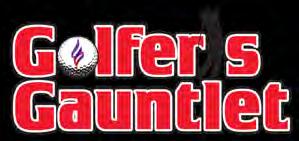

information on our upcoming events!


June 1-Louisville
June 8-Lexington
June 15- Paducah
June 22-Owensboro

KENTUCKIANA
Sting Like a Bee
PAR 4 • 494 YARDS
This hole has an island fairway that is especially difficult because it doglegs to the right and then leaves an approach shot of 170-190 yards to an elevated green. One of the deepest bunkers on the course sits to the right of the angled putting surface, while the bluegrass rough to the left is gnarly and painful.
52 KENTUCKY MONTHLY MAY 2024
Page Sponsored by EPILEPSY FOUNDATION OF
12
ADVANCED BUSINESS SOLUTIONS

13 The Limestone
PAR 4 • 351 YARDS
Don’t let the distance deceive you: Yes, it’s the shortest two-shot hole on the course, but those two shots have to be good. A cluster of six bunkers sits just to the left of the fairway landing zone, while the green is a true island, surrounded by water and built up nearly 20 feet on large limestone boulders.

kentuckymonthly.com 53
Page Sponsored by
Hole

BOURBON FESTIVAL

On the Rocks
PAR 3 • 254 YARDS
This is the longest par 3 on the course and also one of the best views of the surrounding countryside. The serene setting gets more serious around the two-tiered green, which is sandwiched between two bunkers in front and two behind. Playing from either of the two rear bunkers can be especially painful, as the green slopes from back to front.
by
Page Sponsored
KENTUCKY





Unfortunately, that’s not mint julep in Brush Run Creek, which runs down the entire right side of the hole. The landing area is framed by deep bluegrass rough to the left and a large bunker to the right. The creek and a small bunker edge the right side of the large green, with a bigger bunker on the left.
kentuckymonthly.com 55
270 15 .org .org Support Good Causes win rare win rare & & Charitable Gaming License: ORG0002703 PAR 4 • 435 YARDS
Julep Page Sponsored by GIVE



… from Ashland to Paducah, 3.8 million Kentuckians benefit from the Kentucky Colonels’ Good Works Program. Children, veterans, people with disabilities, the hungry, and the homeless all find help through the services of 343 nonprofits receiving grants from us last year.

2023
$3.1 Million 343 Grants Since 1951
$63.1 Million 8,498 Grants
Because a Colonel Gave... PAR 4 • 508 YARDS
KyColonels.org | 502-266-6114

Brush Run Creek lines the right side of this slight dogleg-right. But the real difficulty is the formidable green complex, which features two bunkers in front and a severe dropoff to a closely manicured chipping area to the right. The natural amphitheater is a prime spot for spectator viewing.
56 KENTUCKY MONTHLY MAY 2024
Page Sponsored by HONORABLE ORDER OF KENTUCKY COLONELS
16 Homestretch
Straight Up

The tee shot must find the uphill, left-angling fairway, which means avoiding the two large bunkers—one on each side of the landing area. Then the approach must find the green, which is completely surrounded by trouble—two bunkers to the left and tightly mown turf everywhere else.



kentuckymonthly.com 57
Page Sponsored by KENTUCKY DEPARTMENT OF PARKS
meals.
Over the mountain and through the woods, to Kentucky State Parks we go!
17
Come for the golf, stay for the stunning views and mouthwatering
Overnight packages are available at Kentucky State Parks’ 13 nationally recognized courses. Find yours at parks.ky.gov/golf
My Old KY Home, 40 mi south of Louisville
PAR 4 • 472 YARDS
Pine Mountain, near Cumberland Gap
Bob Hope and Foster Brooks paired their love for golf and Kosair Kids.

Their legacy lives on as we continue to help children in Kentucky and southern Indiana live life to the fullest.

Will you help a Kosair Kid like Addi today?

Scan the QR code or visit: kosair.org/donate


FOR KIDS
PAR 5 • 570 YARDS
This epic finishing hole bends gracefully to the right, with a large bunker to the left of the landing zone and a beautiful water feature on the right. Most players can get home in two but will have to contend with a big bunker in front and a smaller pot bunker on the left.
shaped green has distinct putting areas at left, center and right, so simply getting on the surface is no guarantee of a good score. Page Sponsored by KOSAIR

58 KENTUCKY MONTHLY MAY 2024
18

WC ENJOY RESPONSIBLY. Blade and Bow Kentucky Straight Bourbon Whiskey 45.5-46% Alc/Vol. Stitzel-Weller Distilling Co., Louisville, KY. 2024

Juniors and seniors in high school from across Kentucky come to Gatton to take courses at Western Kentucky University, conduct research, and study abroad. They thrive in Gatton’s supportive environment designed just for them. With scholarships covering tuition, housing, and meals, Gatton students explore their infinite possibilities.
Explore your infinite possibilities. Applications for the Class of 2027 will open August 1, 2024. Learn more at www.wku.edu/academy.
WEBSITE: wku.edu/academy EMAIL: academy@wku.edu

PHONE: 270-745-6565 facebook.com/gattonacademy @gattonacademy

Award-Winning STEM-Focused Academically Rigorous




TODAY, I AM CANCER FREE

“In 2020, learning I had cancer was a shock. As I made the decision about where to receive treatment, I was led to the outstanding treatment facility that was here at home — the Lawson Cancer Center at PMC.
I’m so thankful that I did my treatment here. The quality of care I received was second to none. The doctors, the nurses, the support staff — everyone involved — became family. I don’t feel like I could have gotten the same treatment in a larger city or institution.”
– Robert Staggs





CANCER can be defeated.
Ky Monthly Ad 2024.indd 1 3/12/2024 2:24:00 PM
pikevillehospital.org | (606) 430-2212

Long Ago in Virgie
This 1940s photo shows company houses in the coal-mining town of Virgie in western Pike County. The town originally was established as Clintwood on April 3, 1890. The name eventually was changed to honor Virginia “Virgie” Varney, the daughter of W.O.B. Ratliff, a prominent landowner in the Pikeville area.
The 1901
27th
the Kentucky Derby.
race
29, 1901. K E NTUCKY E XPLORER A section for Kentuckians everywhere … inside Kentucky Monthly. Featuring Things Old & New About Kentucky Volume 39, Number 4 – May 2024 All About Kentucky Your Letters -- page 62 The Road That Crime Built -- page 66 The Marrying Chestnut Tree -- page 69 “I Remember” By Our Readers and More!
Kentucky Derby was the
running of
The
took place on April
Kentucky Explorer
a magazine published for Kentuckians everywhere
Charles Hayes Jr. • Founder
Stephen M. Vest • Publisher
Deborah Kohl Kremer • Editor
Rebecca Redding • Typographist
One-Year Subscription to Kentucky Monthly: $25
Mammoth Cave Area Has So Much History
Many of my kin are from the cave area. My mom lived in the cave area for her first eight years.

We are kin to the Les and Mable Shackelford. I’ve been told that in the 1930s, Les’ parents owned the land where Mammoth Cave is.
I’ve read Cecile Goode’s book World Wonder Saved: How Mammoth Cave Became a National Park, and it is very good!
Margie Winslow, Glasgow
Margie wanted to share this recipe with our readers:
John Ben Getty
1½ pounds ground beef
1 green pepper, chopped
1 small onion, chopped
1 tablespoon shortening
1 6-ounce package narrow noodles
1 can English peas
1 can tomato soup
Grated cheese
Brown beef, pepper and onions in shortening. Cook noodles according to package directions, drain them and add to meat mixture.
Add peas (not drained) and soup and pour into a greased 8- by 11-inch pan. Cover with grated cheese and bake at 300 degrees for 20 minutes.

A Story … and a Poem
By K. David Wheeler, Mount Dora, Florida
Doc Wheeler, who lived in the area known as Skaggs in Lawrence County, was a large-animal vet. He didn’t treat cats and dogs, but racers, pacers, plowers, haulers and cattle.
My dad said that the “senior horse retirement living facility” was really a large shed. A barn was unaffordable. That, and the adjoining small pasture, were Wheeler farm fixtures during the 1920s and ’30s. Wheeler did not like to euthanize animals that had spent their lives working for others.
When racing, pacers’ left and right legs move in unison and opposite to each other. If that timed coordination fails, the pace is broken, and the horse is disqualified. The closer the rear hoof comes to filling the imprint of the front hoof, the faster the horse usually is. Wheeler observed this on the dirt tracks during warmups. His observations were validated by race results. He forbade his son Kermit, who was his assistant, to tell anyone which horse looked best pre-race or to use those observations for betting. Neither one did.
Wheeler was morally strong, and Kermit became a Methodist preacher.
OLD HORSE
Got an old horse unable to race.
Got an old horse unable to pace. No room in the barn.
Got an old horse unable to plow.
Got an old horse unable to haul. No room in the barn.
Got an old horse I don’t need.
Got an old horse I won’t feed. No room in the barn.
Got an old horse I can’t trade.
Bought a new horse. No room in the barn.
Let my old horse loose by Skaggs Hollow. Doc Wheeler will have the old horse follow. He always makes room in his barn.
That’s why he ain’t rich.
62 THE KENTUCKY EXPLORER In
1994,
the Tulip Poplar was named the Kentucky state tree.
FOUNDED 1986, VOLUME 39, NO. 4
In
1948-2019 Letters to the Kentucky
Letters may be edited for clarification and
Kentucky Explorer appears inside each issue of Kentucky Monthly magazine. Subscriptions can be purchased online at shopkentuckymonthly.com or by calling 1.888.329.0053.
The Mammoth Cave Historic Entrance
memory of Donna Jean Hayes,
Explorer
brevity.
When My Mom Drove a Race Car
By Hubert E. King Jr., Flemington, New Jersey
Dedicated to Laura Mae King, an adventuresome spirit
With race cars in my genes, it’s no surprise that I enjoy driving my Porsche on the track. At Porsche Club of America’s Driver Education events, we are surrounded by skilled high-performance drivers—from our fellow drivers to seasoned instructors. We take inspiration from icons of professional racing, such as Hurley Haywood. To me, my race car-driving mother, Laura Mae, is a hero.
The acrid smell of racing fuel hung in the air, along with clouds of dust kicked up from the dirt track, pit and access roads. It was a hot and humid Kentucky day in 1957, but my friends and I were accustomed to the summer heat. Besides, we had been playing in the shady woods around the track. When you are 6, watching seemingly endless time trials is not appealing. However, we were now glued to the track-side fence. Mom had worked her way through those time trials to the final group, one car off pole position. A few of my friends’ dads drove in these races, but I was the only one with such a daring mom.
Mom arrived in Kentucky in 1924, joining her father, who had moved from Western Tennessee to escape the low-paying jobs there. He moved the family to a small gentlemen’s farm located at what is now 6084 Taylor Mill Road in Taylor Mill earning good wages working for the railroad. Directly across the road lived an unusual family. The Kings had arrived in Kentucky in 1785. The patriarch was a veteran of the Revolutionary War, and he benefited from land grants and shrewd investing to grow his fortune. As with all such families, things happen, and later generations endure their ups and downs. Due to a financial downswing, this particular branch of the Kings had to move their entire family to a tiny house, their former summer cottage.
Time passed and high school graduation came. After graduating from Simon Kenton High School in 1939, Mom needed a job. Riding the local bus into Covington, she received training as a hair stylist, and soon after, she began work as a stylist at a salon. This particular salon was known for its sophisticated style and was owned by a dashing woman named Frenchy. Located in Newport, a city with connections to the mob, regular clients were part of the defining “mob wife” style of the day. How did Mom work that? She decided she could do it, and that’s where she belonged. My mom’s style soon attracted notice from the handsome neighbor. He was charming, worldly and, by the way, drove a great Packard convertible. Mom sensed something, and they might have gotten married sooner, but this being the World War II years, he had decided that his calling was to be a pilot and that his fast track to do so was going to Canada and enlisting in the Royal Canadian Air Force. Like Mom, my dad, Hubert E. King Sr., decided that’s what he wanted, and that he could do it. They got married when he was on leave, and their adventures together began.
After he earned a few medals from the Canadians, the United States Air Force wanted Dad. He and Mom soon were bound to flight training school in Miami. He flew planes all day, and they partied all night. Then, it was off to another school, this time in Dodge City, Kansas. They embraced each new place and made it their home. Eventually, Dad was deployed to Europe and Mom went back to the salon. He arrived home, a decorated pilot, and they began a new life wondering how to satisfy their shared adventurous spirit.

Soon, they were fire chief and ambulance corps captain for the Taylor Mill and Community Volunteer Fire Department. Dad took up big-game hunting. Mom set up her own place, Laura Mae’s Salon, housed in their newly built home on Taylor Mill Road. But something still was missing.
What the area needed was excitement. It needed a racetrack! Dad and similar-minded fellows decided that all they needed was someone with ample land and some earth-moving equipment. A convincing argument of profit potential inspired Paul, a local contractor. Hilltop Speedway was built on Paul’s farm (Stephens Road, County Route 1486). It was a 3/8-mile oval track with a wooden grandstand, a concession stand and an announcer’s tower. There was not a spot of pavement anywhere but plenty of dust! It was a great success, and folks in the community became spectators or racers. (A lake now occupies the site of the old track.)
Dad built our car, 4-Q, at his service station, Oak Ridge Standard Oil at 5980 Taylor Mill Road. He and his mechanic, Casey, were selftaught about highperformance (then called hot rodding), and they modified the engine and chassis for short-track racing. As you can see in the photo, function prevailed over form. No one had driver training, it was seat-of-the pants driving, and my mom was good. Mom, my uncle and Dad all took their turns driving the 4-Q. It was Mom at the wheel that afternoon as the cars circled the track behind the pace car. At the green flag, everyone took off, with 4-Q in the lead. Mom had a real intuition for driving. It was she, not Dad, who first informed me on speed-driving techniques. I have never forgotten her explanation how, in a curve, to make the move onto the throttle coming out of the apex (of course, she didn’t call it an apex). Well, on this particular afternoon, she drove her very best, taking the checkered flag in first place. My friends and I went crazy when she was called to the stand to claim her winner’s trophy. That was a prize she kept in a place of pride at the house and for which she was known in the neighborhood. A friend recently told me, “Oh, I remember your mother well. She styled my hair and drove race cars.”


May 2024 63
Knott County was formed in 1884 and is named for James Proctor Knott, governor of Kentucky, 1883–1887.
. . .
Laura Mae and Hubert E. King Sr.
Send memories to Deborah Kohl Kremer at deb@kentuckymonthly.com or
P.O. Box 559, Frankfort, KY 40602.
“I Remember” By Our Readers
Send your memory in today!
Travellers Rest
By Jerry Ward
My mom, Irma Helen Scott, was born in 1913 at Travellers Rest in Owsley County. This memory of hers took place in the late 1920s.

Though her family lived in Winchester, they returned to Travellers Rest each summer, right after school was out, and helped the grandparents and other relatives with the gardens and eventual canning of corn, beans and “maters” in September before returning to Winchester for the start of school.
Mom’s father, Palmer Scott, was the baseball coach at Travellers Rest during those years, and one of the players on his teams was Earle Combs. Combs, born in 1899 at Pebworth, is a legend in Owsley County. Our family story is that Palmer drove Combs to the train station in Louisville when Combs was signed to play baseball for the New York Yankees, and the rest is history.
The baseball field at Travellers Rest was located on the Rowlette Branch Creek just south of what was Travellers Rest proper on Ky. 847. It’s barely a wide spot in the road these days, but it does not take much imagination to stand at the ball field area today and visualize those games of the past. The Rowlette Branch was along the first base line and, as any baseball fan knows, most batters are right-

handed, thus most foul balls are to the right of the first base line. Thus, Rowlette Branch was where kids could sit, watch the game, wade and swim, and chase foul balls! Kids got a free pop or popcorn for returning the foul balls to the concession stand.
I wonder if that reward process takes place at local baseball games today. My mother had eight younger brothers, and those boys chased foul balls and fought one another for the ball.
My long-gone Travellers Rest relatives told me that in those days (the early 1900s), that area was home to more than 2,000 people, and I have had tours of the area where several stores used to be located.
This photo of the Owsley County Court House in Booneville with the image of Earle Combs on the exterior was taken in 2019. Jerry asks readers if the Combs photo is still there.
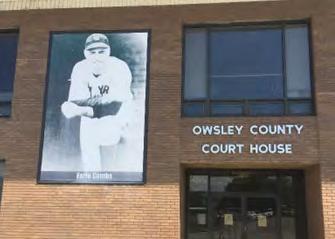

Irma Scott Ward is pictured in 1994 in the Botner Cemetery that overlooks “downtown” Travellers Rest, which has virtually disappeared since the1940s. Near the road is the Rowlette Branch that flows into Sturgeon Creek, and the baseball field would have been about a quarter-mile to the right of the creek intersection. In 2019, our most recent visit to the area, we had a difficult time finding the small gravel road leading to the cemetery; right, the Sarah Botner Store at Travellers Rest, around 1940. Sarah is in the doorway at right, next to the lady in the bonnet. Her brother, Millard Botner, is seated with a dog on either side.
4 THE KENTUCKY EXPLORER 64 THE KENTUCKY EXPLORER
“Sometimes just being still is the best thing you can do for yourself.” Kentucky Poet Laureate Silas House
mail to Kentucky Monthly, Attn: Deb Kremer,
Left,
Warm up by the stove at Curt’s Store
By David R. Caudill, Daytona Beach, Florida
I was 14 when my family moved back to Kentucky in 1953. One of the most interesting things I saw was the country general store. I was used to supermarkets or small mom-and-pop grocery stores in the other places we lived, and the country store found in the hollows of Kentucky fascinated me. Never had I seen a grocery store, shoe shop, clothing store, hardware store, meat market, feed store and delivery service under one roof.
Ours was owned and operated by Curt Engle and located on Big Willard Creek in Perry County at a junction where the road continued farther up the creek past Big Willard School. The other road traveled up Rockhouse Fork of Big Willard, where it left the creek and continued onward over the hill to Grassy Branch in Leslie County. It was an ideal location that brought Curt many customers.
Curt did not have a huge store, but every nook and cranny was filled with merchandise. Upon entering, the first thing to grab your attention was a large pot-bellied coal stove that occupied a prominent space in the middle of the sales area. Curt always arrived early on cold winter days and often had the stove so hot it got cherry red. We students who walked out of the hollows to catch the school bus really appreciated it.
The counter stood to the right with a large jar of pickled bologna always ready for sale. Five cents got you a two-inch piece, and, of course, a dime got twice as much. Crackers were included. The pop cooler stood to the right front of the counter, and pop cost 6 cents.
Everybody called pop dopes. I never could find out where the name came from. I suspect it might have originated from the rumor that Coca-Cola put small amounts of cocaine in its product before it added caffeine. Or it might be that only drug stores originally served cola at their soda fountains.

This is not Curt’s Store but a photo of a general store in the 1950s. Before the days of big-box stores and supermarkets, the general store was the lifeblood of a community.
stacked on long tables. There wasn’t a large variety, but he seemed to sell a good amount. What drew my attention were the pants. In the 1950s, men and boys wore jeans laced up the rear like tennis shoes. I wanted a pair of those as they were the style. The first money I earned hoeing corn went to buy me a pair.
Boxes of shoes lined the side wall. They were substantial shoes. By that I mean they were leather and meant for dress or work, including work boots. Remember, this was the time before Adidas, Nike, etc., and was a time when the only people wearing sneakers or tennis shoes were dirt poor. Curt didn’t sell many shoes because the boxes always had a coating of dust on them. However, they were there, and I bought shoes there.

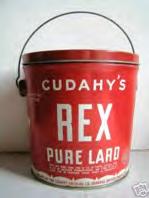
The wall behind the counter had shelves filled with canned and dry goods. If you asked for a jar of pimientos, you were out of luck because Curt didn’t carry them. He did carry most things his customers wanted such as basic canned goods, sacks of flour and meal, bags of pinto beans, 4- and 8-pound buckets of lard, cigarettes, matches, chewing tobacco, cans of carbide for lamps, and basic first-aid supplies such as alcohol and Merthiolate. By the way, those 4-pound lard buckets made great lunch buckets. Many grade-school students carried their milk and cornbread lunch in them.
The meat cooler formed an “L” at the end of the counter. It held very few chops, steaks and roasts found in meat markets and mostly rolls of luncheon meats such as bologna and pickle loaf, plus bacon and salt pork. In an area that killed its own hogs and occasional beef, most meat sold was convenience meats used in sandwiches for miners.
The left side of the room was devoted to clothing. There, Curt had shirts, pants, socks and underwear
The front of the store was devoted to feed and hardware. Curt carried Bossie Cow Feed and corn. Bossie came in patterned cotton sacks suitable for making shirts and blouses. I became familiar with sacks of Bossie. In the fall and spring when the roads froze and thawed, they became impassable, and I was forced to carry the sacks of feed on my back from where my dad had parked the car. Curt also carried a few tools such as hoes, shovels, coal buckets and hammers.
Finally, odds and ends were placed around the sales area. These included ladder-back chairs for customers to sit on, 50-pound buckets of lard, coal for the stove, a trash box, a keg or two of nails, and a coal oil container with a hand pump. Curt’s store had just about anything one needed.
The store also provided delivery. If you placed a large order, Curt delivered. He had a 1½-ton Dodge Stake Bed Truck, and his sons delivered up in the hollows. One might have to wait until evening to get it, but get it he did. And if the house was across a creek and up the hillside, Curt’s boys carried it over.
Speaking of carrying. Curt, like all country store owners, carried many of his customers from payday to payday. He used a green ledger book to write down every purchase and its price. Then on payday, his customers stopped by to settle up. He certainly carried our family, and I don’t know what we would have done without it.
Curt is gone now. He was a good man who went out of his way to provide a needed service. I think of him often, and I bet many others do also, especially students with frozen ears and noses running from the cold who gathered around that old stove.
Comedian and
was born in Louisville on May 11, 1912. He died in 2001.
actor Foster Brooks
General store staples Merthiolate and lard.
The Road That Crime Built
The following story was written by Jesse Stuart. It is the story behind the construction of Ky. 784, which runs along Dummitt Ridge in Greenup County. The road was envisioned by William “Bill” Adkins, who was the county judge in the 1950s. Thanks to Bill’s son, Gary Adkins of Richmond, for sharing this with Kentucky Explorer
Memorial for a Public Servant
By Jesse Stuart
After [my wife] Naomi and I visited Dummitt Ridge yesterday, I wanted to find out why one of the few good roads in Greenup County was built on that ridge, what it had cost, why it was built, and who was behind this project. When Cousin Bill Adkins, a third cousin to my father, was county judge, I had heard people talking about his wasting the taxpayer’s money on some fantastic road project that only went to a cemetery and a few sawmills.
“We won’t have any trouble finding cousin Bill,” I told her as we drove down the valley. “He’s a very methodical man. He will be at Leslie’s Drug Store at 4:30 promptly to get his paper. After he gets his paper, he will sit there and read the front page news.”
“Then, that’s fine,” she said. “While you talk to him, I can get this grocery list filled.”
In a few minutes, we were in Greenup. Naomi went to Uncle Vernon Kendall’s store while I hurried to Leslie’s Drug Store. Sure enough, there stood Cousin Bill out in the middle of the floor reading his paper.

“Bill, I’ve got something to ask you,” I said, laying my hand on his shoulder. He didn’t like to be disturbed when he was reading his paper. “I hear you are the father of the Dummitt Ridge Road. Is that true?”
“Yes, that was my pet project when I was the judge,” he admitted in a low voice so others in the drugstore wouldn’t hear him. “Have you ever been over this road, Jesse?”
“Yes, Naomi and I were from one end to the other yesterday,” I replied. “We found one of the best roads in this county and a very interesting locality.”
“I am happy to hear you say that,” he said, smiling. “A lot of people were never pleased with that project. They didn’t know how badly it was needed.”
“Come over here, and let’s sit down at the fountain and talk about it,” I suggested. “I hate to disturb you. But I am interested in the Dummitt Ridge Road.”
“I can read my paper after I get home,” he said. His face beamed as we walked over to the row of empty stools. Cousin Bill dropped down on one, and I sat down beside him. “I’ll be glad to tell you everything I know about that road.”
I pulled my notebook and fountain pen from my pocket.
“The Dummitt Ridge Road goes back to a dream,” he said.
“Who had that dream?” I asked. “Tell me more about it.”
“I had the dream,” he replied. “You know, Jesse, I have been a public servant of the people here most of my life. I have served them the best I could.”
“You’re right,” I said, agreeing with him.
“For 16 years, I served as deputy sheriff under three different high sheriffs,” he continued. “And I served four years as Greenup County sheriff myself.”
“Yes, I remember many of those rough-and-tumble years,” I said.
“I served under Earl McKenzie, George Crisp and Jake Fisher,” he continued his story. “You know a high sheriff can’t succeed himself in this state. That’s an old joke. If he lives through his four-year term of office he would never want to succeed himself. He would be afraid. I mention this for a purpose. I have checked Greenup County sheriffs and their deputies back to 1800, and I am the only many who served 16 years as a deputy and four years as a high sheriff in this county. I have heard a few bullets sing mighty close. But I am still alive.”
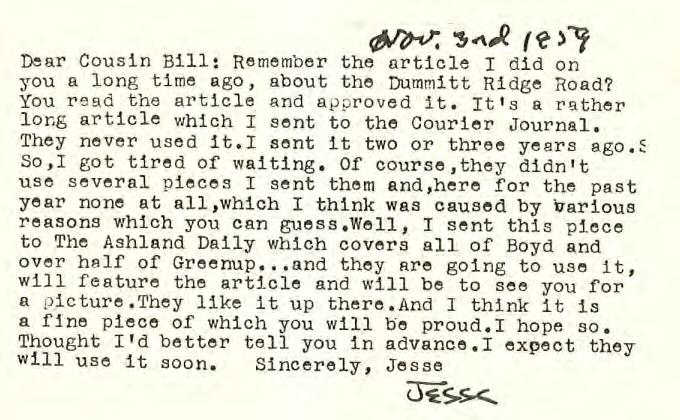
Bill Adkins was surprised that he was alive. But I wasn’t surprised, for he had the cool courage to arrest a man when the going was rough. He was a fearless man who used caution with a smile. He had arrested the desperados where other boastful sheriffs and their deputies had failed. He had really been a good public servant to us. He had lived from a very small salary.
“I served my first term as deputy sheriff of this county back in the Prohibition days, when the going was rough,” he continued. “I was a young man when I was sent out to make the arrests of the killers and the whiskey violators.
6 THE KENTUCKY EXPLORER 66 THE KENTUCKY EXPLORER The area known as Kentucky was home to five different Native tribes –
Left, William “Bill” Adkins; below, Stuart’s letter to Bill Adkins regarding this article he had written about the road.
Of course, I made arrests of all other violators, too. But I was used especially in the tough places. Dummitt Ridge in those days was really the toughest place we had. Honest, it was dangerous for a sheriff to go into that country. Often, I had to go there alone for another deputy couldn’t be spared to go with me.”
“Tell me how on earth you got up on Dummitt Ridge 20 years ago?” I asked him.
“I was just coming to that,” he replied. “I didn’t go up there the Greenup County way, for we didn’t have a road to that ridge. I drove down the Ohio River road, which didn’t have a foot of hard surface in those days. Then at Garrison in Lewis County, I left the main river road and went up Briary to the steep foothills, where I parked my old car and climbed the mountain to Dummitt Ridge. That’s how I got there. I never went to that lawless part of Greenup County that it didn’t take two days. I was a day getting there and one getting back.”
“Where did you sleep?”
“I didn’t sleep,” he replied. “I have been three days and nights going to get a prisoner and fetching him back. It was then that I had dreams of doing something about Dummitt Ridge. Even up until 1950, it was a tough hideaway spot to reach. It was hard to drive a car in there. One had to drive an old car over the log roads men had made to get their sawed-out timber out. And that was the year I was elected judge of Greenup County. I thought after I had to make arrests on that ridge where nephew had killed uncle and cousin had killed cousin and where so many killed their neighbors, that a good road into that place would stop most of the lawlessness.”
“That’s really an idea,” I said. “I had never thought of one’s building a road against crime.”
“That’s what it is,” he continued. “I was criticized over getting that road because there are only a few houses on it.”
“We traveled for miles and never found but three houses,” I told him.
“Yes, but they were once there,” he spoke softly with a wry little smile as he looked at me. “That ridge was filled with moonshiners and bootleggers. Now, many of them have gone over into Lewis County.”
“Now, somebody will have to build a good road into Lewis County,” I said.
“It would break up lawlessness,” Cousin Bill spoke with confidence. “You’ll be surprised what a good road will do! Now it used to take me at least a day to get to Dummitt Ridge. And the whiskey element in the Prohibition days had their spies planted in Greenup to watch for strangers talking to the sheriff and his deputies. They thought they were Federal men, and there would soon be a raid. The spies often guessed right. And they didn’t take any chances. They sent a man on horseback to Dummitt Ridge to warn the moonshiners in a hurry. By the time I got there with the revenue men and my deputies, there wasn’t a still in operation. Everybody had been tipped off by the grapevine. Somewhere at different stations along the way, the rider on horseback was given fresh horses, so he could get there in a hurry. He always got there before we could go down to the river and up Briary in cars and climb the mountain. Now, a man can
drive from here to Dummitt Ridge in 40 minutes. He can go up Big Whiteoak to Dummitt Ridge. He can go up to Leatherwood to Dummitt Ridge. And he can go up Three Prong. The high sheriff can ride out there now.”
“What’s the name of the new road you built up there?” I asked.
“It’s not got any name,” he said.


The location of Dummitt Ridge Road.
“Not the Bill Adkins Highway, huh?” I teased him.
“No, but a better name for it, maybe,” he chuckled, “is the road that crime built.”
“Was that always a whiskey section of this county?” I asked.
“Before Prohibition, it was a fine community of hardworking people,” he said. “First people who ever came to this county lived there. They are buried up there at The Granny Thomas Graveyard. Did you see it?”
“Yes, we stopped there,” I told him. “We found this cemetery, a very interesting pioneer cemetery.”
“We had good dirt roads over all the county but the Dummitt Ridge section,” he said. “We could go anywhere by automobile at night to make our raids except to Dummitt Ridge. Then our moonshiners moved to that inaccessible ridge where they thought we would never reach them. They moved in and pushed the old settlers back and took the ridge over. But when we got the road back there, these same people pulled out for another wild country, the McDowell area in Lewis County. They left only a few of the old settlers who had helped to pioneer this county. Most of them are up there in the Granny Thomas Graveyard.”
“When I visited that place yesterday, I saw all those graves with fieldstones at their head and feet,” I said. “I wondered how many of them had died before their time because they couldn’t fetch a doctor there or bring a patient out to a doctor or the hospital.”
“You would be surprised how many of them died before their time,” he said. “I happen to know men knifed in fights who bled to death. Their magic sayings to stop blood didn’t always work. Men wounded by bullets would have lived, too, if they could have had medical care. Women died in childbirth out there because they didn’t have the right care. This is another reason I worked and pleaded with the State Highway Department to get them to build a road. Now, the people living on Dummitt Ridge can have medical attention.”
– the Iroquoian,
May 2024 67
Sioux, Algonquian, Muskogean and Yuchi.
The Road That Crime Built,
“But when you got the road, the people left,” I said.
“Well, some of them,” he admitted begrudgingly. “But people will come back to the ridge. Let me tell you this story. You remember the house when you went up the right fork of Three Prong and first reached Dummitt Ridge?”
“Yes, I remember that house,” I said. “It was the first one we saw on the ridge.”
“A man by the name of Jamerson lived there,” he told me. “He had lived in this house all of his life. And he was ready to leave that ridge before we started building that road. He had his two-story house and farm up for sale and couldn’t get $1,000 for it. He didn’t want to leave there, but he saw good roads everyplace else, and he wanted to give his children a better chance. So, when we started building the road, he stayed on. When we got the road past his house, he was offered $3,000 for his place. He wouldn’t take it. And before we got the road built, he had died. I keep thinking about that man. I wish he could have lived to have enjoyed the first road that ever was on that ridge.”

“Any more whiskey-making going on out there?” I asked.
“No, the road ended it,” he said with a chuckle. “And I figured it would. They thought they had found a place safe from the law.
But the new road gets the law to them in a hurry. Oh, yes, there will be a moonshiner here and there, like over other parts of the county. But moonshining isn’t the profession of the majority of the people now. And another thing, Jesse, the young people can ride off that ridge to high school now. This is the first time in the history of Greenup County the children of Dummitt Ridge could live at home and go to high school. Now, they will become farmers, teachers, nurses and doctors, and they will go back there and change that country. See, what other kinds of progress a good road will bring!”
“Yes, the road that crime built has obliterated crime,” I said. “Sounds like a paradox.”
“That new road has already changed the face of this county,” he said with a smile.
“When we were out there yesterday, I saw three sawmills in operation,” I told him.
“That’s a timber country,” he said. “It wasn’t worth much until we started putting the road through. And for reasons of their own, many didn’t want the road, and they made us pay dearly for that ground. The ground there wasn’t worth more than $6 an acre, and it used to sell for $3 before we started to build the road. They tried to block us every way they could, but we condemned the land and went on with the road!”
“That road opened up a scenic country for people who live in the cities down in the Ohio River Valley,” I said.
“Yes, it opened up a country for the hunters, too,” he said.
“Fox hunters come by the carloads on summer nights. See, there are deer and pheasant in this section too! This is the last wild country left around here!” he said.
“Now, do you have any figures on what it cost to build the road?” I asked.
“I have the exact figures over at my house,” he said. “I can tell you almost the exact amount it cost.”
“That will be close enough,” I told him.
“See, we started this road at Sunshine down in the Tygart River Valley,” he explained. “We brought it all the way up to Schultz and up to Dummitt Ridge and out this ridge to the Carter County line. It took from 1951 to 1954 to build it.”
“Three years to build it?” I asked.
“The first 9 miles from Sunshine to Sugar Camp we built in 1951 at a cost of $86,000,” he said. “Part of that is hard-surfaced road. Now in 1952, we built the next 6 miles from Sugar Camp to the head of the Schultz, and up to The Granny Thomas Graveyard at a cost of $91,000. In 1953, we built the last 7 miles from The Granny Thomas Graveyard out Dummitt Ridge to the Carter County line at a cost of $82,000.”
“Then, this road that crime built cost the taxpayers of Kentucky well over a quarter of a million?” I said. “No wonder some of the taxpayers howled over spending this on a road that serves only half a dozen families left on Dummitt Ridge.”
“Then,” Bill spoke in a surprised tone at my reaction, “you can’t spend too much money to prevent crime! It saves the taxpayers money in the long run!”
“But I’m all for you, Bill, and your project,” I said. “I think it’s wonderful. I think it’s fine to open up this area of Greenup County to give those few children, descendants of our earliest settlers, left there a chance. There might be a great doctor, evangelist, novelist or scientist among them. That’s the old pioneer stock that fought and died for this country. Your road is a scenic drive, too. People can drive up there now and leave the Ohio River Valley if and when there is another flood like in 1937!”
“Then, I’m happy that you agree with me,” he said with a big smile. “Many don’t agree with me now, but someday I hope they will. That road will pay for itself a hundred times. For the next century and maybe longer, this road will take the people up in that land of the sky to level acres of ridgetop, where there are good building sites, meadows, deer, pheasant, clouds and plenty of fresh air. That’s a fine country now. The old pioneers have died, and the lawless elements have vanished. Only a few of the old stock remain. It’s almost a new country.”
“Because you had a dream, you have opened it up again to the people,” I told him. “If you don’t mind, I’m going to write something about how a good road changed a whole county. And right now, I suggest we call this road The Bill Adkins Highway. Let his road be named as a memorial for a good public servant who has given us the best years of his life.”
If you are interested in other articles and books by Stuart, visit or contact the Jesse Stuart Foundation, 4440 13th Street, Ashland, KY 41102, 606.326.1667, jsfbooks.com
68 KENTUCKY MONTHLY NOVEMBER 2020 The
the
is a National Recreation Area managed by the United States Forest Service. 68 THE KENTUCKY EXPLORER
Land Between
Lakes
Jesse Stuart
continued
The Marrying Chestnut Tree
By Bobbie Smith Bryant, Jefferson County
Well over a hundred years ago in the Jackson Purchase, there was a special place where young brides and grooms went to get married. While some eloped, other fanciful lovebirds planned their “I do’s” for this popular place of sacred matrimony.
This site became known as the Marrying Chestnut Tree. Kerby Jennings wrote about the tree in his Story of Calloway County, 1822-1976, saying it was located just east of Hazel and over the state line, fully 6 miles west of Hell-Fer-Sartin Creek and a short distance from the Hazel Hotel. (The tree actually was located in Henry County, Tennessee.)
In a column titled, “Musings from the Philosopher,” an unnamed eyewitness from those early days wrote the following in a June 12, 1969, article in the Fulton County News:
In my youth and long after, the laws of Tennessee permitted marriages on a slightly lower aged scale than did Kentucky. If the wedding was to be a real elopement, the prospective bridegroom and one of his friends secretly made their way to Paris, Tennessee, and got the license. Then, attended by a couple or two in their buggies, the couple to get married took a drive, usually starting out as if to go in any direction except south. On the way, they were joined by their attendants, and on they went to meet the marrying parson or justice of the peace at the Chestnut Tree.
While there were numerous notices in local and regional newspapers announcing the knot-tying at this tree of wedlock, the following stories captured my attention.
June 7, 1906, Paducah News-Democrat
Mr. Tom Williams and Miss Fannie Linn eloped to Tennessee and were married last night. Miss Linn is a daughter of Judge L.C. Linn and is a very pretty and highly accomplished young lady. Mr. Williams is one of the most popular young men in Murray.
The wedding was tinged with romance and not without its humorous side. When the couple left Murray for the old chestnut tree on the Kentucky-Tennessee line, the Gretna Green of hundreds of West Kentucky lads and lassies, they arranged that Elder W.J. Beale should follow them and officiate at the wedding. In some way, the minister became lost in the Clark’s River bottom near Murray and failed to appear at the chestnut tree at the agreed-upon time. After waiting for some time, the groom, not to be thwarted, drove to Hazel, a town nearby, and the services of a minister was secured to tie the knot.
The happy couple then returned homeward. At a late hour, long after the young people had reached home and received parental blessings and forgiveness, Rev. Beale, who had finally found his way out of the dense wood, arrived in Murray to find his young friends were no longer in need of his ministerial services, and he could only join their friends in wishing them success and happiness.
Nov. 1, 1921, Murray Ledger
There’s many a slip ’twixt the trysting place and the marriage altar. A certain young man of the county can testify to the accuracy of the statement. Preparations had gone forward for the marriage of the young man, whose name is withheld, and Miss Rubye Whitlow, a popular young lady of the county. The prospective groom’s sister had helped to arrange the fiancée’s trousseau, and the wedding date had been fixed. Saturday, Miss Whitlow attended the Calloway County singing
convention at Pottertown. There, she met Curt Hobbs, a former suitor. He exercised the woman’s prerogative and changed her mind, and in the company of Hobbs, went to the old chestnut tree Gretna Green for Calloway County swains, and there, she was married to Hobbs.
Feb. 2, 1923, Paducah NewsDemocrat
The Rev. J. Mack Pool, who was 82 years old on February 22, performed his 1,554th marriage ceremony under the “old Chestnut Tree,” on the MurrayHazel Road yesterday. Miss Nola Ann Lawrence and Eron Hall “John” Cain were the couple married by Rev. Pool yesterday. The bride is the daughter of Henry Lawrence, who left today for Detroit to make his home.

Recognized as the Grand Champion marrying parson of all of Western Kentucky, Methodist pastor Rev. Pool was highly regarded. His record number of nuptials was reported frequently in the local media as the numbers increased. The final count was more than 1,700 with the last vows being given a few weeks before he died, while he was propped up on his deathbed.
Calloway County Family History
Pool was himself the son of a Methodist minister who reportedly passed away while standing at the pulpit preaching. The area of Calloway County originally known as Pooltown was named for this family.
Stories in the newspapers about the Marrying Chestnut Tree faded away around 1925. Sadly, the chestnut tree no longer stand. An eyewitness description recorded in the 1969 Fulton County News provides this closing note.
When I was a small boy, I just assumed that this famous tree was something special, that it stood in some romantic spot that showed how important it was. Away down in my teenage days (early 1900s), I drove by the place and got one of the big disillusionments of my entire life. The tree was a half-dead old chestnut tree in a very muddy place, so muddy that ruts ran on both sides of it, for even the buggies and wagons had a hard time getting over that stretch of road. I must confess that I have seen several hundred chestnut trees that were more to my idea of a runaway marriage site.
The chestnut tree, like all the trees of its kind, long ago died of blight. I doubt whether anybody now could pinpoint its location, a few yards over the state line in Tennessee.

Pictured are the great-grandparents of the author, Samuel Tilford Brewer and his bride, Lois Etoille Robinson, on Oct. 25, 1914, their wedding day, in Calloway County. Their carriage was the typical mode of transportation for young couples in the early 20th century.
James Harrod established the first permanent settlement at Harrodsburg in 1774. May 2024 69
Rev. John McKinney “Mack” Pool. Photo from the Murray Woman’s Club

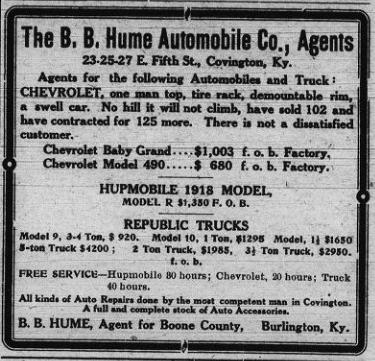
Left, a collage of headlines regarding the moonshining activity in Boone County in the early 1920s; above, an ad for Sheriff B.B. Hume’s car company.
The 1920s: The times they were a-changing
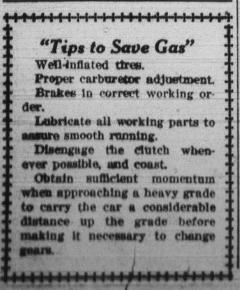
The Rise of Cars and Moonshine
By Hillary Delaney, Boone County Borderlands Archive and History Center
Around 1923, Boone County Sheriff B.B. Hume had his hands full. Aside from his normal duties as a lawman in a mostly rural county, Hume also ran a successful car dealership in Covington. Car ownership was growing rapidly as prices of the new-fangled machines began to drop, making them attainable by middle-class citizens.
Hume’s dealership was a success. Hs daily advertisements for his Hudson-Essex dealership ran in several area papers. In addition to the new autos, Hume ran an ad for the B.B. Hume Automobile Co., which took used cars as trade-ins, selling each individually through the classified ads. Motors were all the rage, so much so that the Boone County Recorder ran a regular “Automobile News” column, offering advice for first-time auto owners. There were helpful tips on maintenance, operation and courtesy to others who shared the roads, particularly pedestrians and horse-drawn vehicles.
The increasing popularity of cars coincided with a growing criminal element that used them for nefarious means. Cars offered speed, which meant a quick exit from the scene of a crime, or as Hume knew, they could serve as rapid delivery vehicles for moonshiners. Along with his county duties and car sales, Hume was a “dry man,” meaning he was involved in ferreting out moonshine stills in the area. Stills were popping up in all
corners of the county, keeping Hume and Deputies L.T. Utz and H. Snyder engaged year-round.
One of the largest operations discovered in Boone County was on W.A. Campbell’s property near the Harvest Home picnic grounds. Acting on a tip, the lawmen staked out the property. Before long, a large touring car with Ohio tags came down the road carrying two men, two women and 25 gallons of contraband moonshine. The bootlegging couples were arrested, and the lawmen located the source of the “hooch.” A still found on Campbell’s land was larger than they could have imagined. The still had 100-gallon capacity. It was confiscated and placed on exhibition at the courthouse in Burlington before being locked away on the second floor of the jail.
Scattered reports of the discovery and destruction of more stills continued. Each time one was shut down, another appeared. Some stills were small, such Elizabeth Tunning’s in Constance, which held only 2 gallons, while other moonshiners had higher volumes.
A 1925 raid on the Robinson farm in Walton revealed a 250-gallon still, 2,600 gallons of mash, and 40 gallons of refined moonshine. Fines were heavy, and punishment could be quite serious for offenders, but business continued to boom for years until the 1933 repeal of Prohibition took the profit out of the game.

Newspaper clippings from the Boone County Recorder Newspaper, courtesy of the Boone County Public Libary.
70 THE KENTUCKY EXPLORER
A natural bridge at Carter Caves State Resort Park is paved and supports traffic—the only such bridge in Kentucky.
Memories of the Derby Clock
The Louisville Clock, also known as the Derby Clock, was a 40-foot-high ornamental timepiece designed by sculptor Barney Bright to resemble a gigantic windup toy.
The clock initially was located at River City Mall and was dedicated on Dec. 3, 1976.
The colorful and whimsical clock featured eight ornamental columns supporting an elevated five-lane racetrack. Each day at noon, a bugle announced the beginning of a race among five hand-carved statues representing figures with local significance: George Rogers Clark, Daniel Boone, Thomas Jefferson, King Louis XVI of France, and the Belle of Louisville

Watching the race from the gazebo of the clock are Louisvillians Mary Anderson, D.W. Griffith, Zachary Taylor, Henry Watterson and the trumpeter Oliver Cooke
When the Louisville Galleria opened in 1981, the clock was moved a block south to Guthrie Street. In 1986, it was relocated to the Kentucky Fair and Exposition Center, but it was plagued with mechanical issues and sat inactive for many years before being removed in 1993.
In 2011, it was restored, repaired and rebuilt on Fourth Street just north of Broadway. In 2015, the land where the clock was located was sold, and the Derby Clock was dismantled.
CLASSIFIED ADS
BURLINGTON ANTIQUE SHOW — 10 minutes south of Cincinnati. Sunday, May 12, 7am-3pm. More than 200 dealers, rain or shine, 513.922.6847. www.burlingtonantiqueshow.com
VACATION CONDOS FOR RENT — Need a relaxing getaway?
2BR/2Bath villa on Hilton Head Island. Multiple pools and private ocean beach. Westin Resort amenities plus free golf and pickleball daily. 3BR/2Bath lakefront condo in Cadillac, MI. Indoor pool/fitness room. All-sports lake. Leave message at 502.292.3100. M
KENTUCKY EXPLORER MAGAZINE — We have a select number of back issues of Kentucky Explorer from 1986-2000. Back issues are $5 plus postage. If you are in search of a certain issue or are interested in adding issues to your collection, please contact Deb at deb@kentuckymonthly.com to see if it’s available.

WANTED — Paying cash for large diamonds; collections of vintage wrist and pocket watches; gold and silver coins; sterling flatware and serving pieces; gold and silver jewelry; collections of arts and crafts and pottery; antique advertising signs; antique walking canes; pocket knives; collections of antique guns and swords; military collections; early hand-crafted crocks and jugs; musical instruments; call Clarence, buyer for more than 35 years; 606.531.0467. (F-D)
WANTED — All types of antiques and collectibles. Top prices for gold, silver and costume jewelry. Scrap gold. Gold and silver coins. Wrist and pocket watches. Collections. Early post cards and fountain pens. Civil War swords and other military items. Vintage toys. Pocket knives. Lighters. Old eye glasses. Pottery and stoneware. All types of railroad items. Advertising signs. Handmade quilts. Marbles. Jars. Much much more. Complete and partial estates. Call Clarence, buyer for more than 30 years, at 606.531.0467. (F-D)
May 2024 71
Country singer/songwriter Tom T. Hall was born in Olive Hill on May 25, 1936. He died in 2021.

Baseball’s ‘Outsiders’
Gary Cieradkowski tells the stories of 21 figures from baseball’s rich history and embellishes the stories with his illustrations.
True to his affection for “outsiders” far removed from the fame, money and bright lights of big-time baseball, Cieradkowski profiles flashes-in-the-pan, Negro League stars, a pioneer of Japanese baseball, a world-famous comedian, a teenage girl who played (successfully) against men more than a century ago, and a fictional outfielder, among others. A few of the players he writes about are Hall of Famers, but their stories are obscure footnotes from their illustrious careers.
An artist and author from Fort Thomas, Cieradkowski digs deep into his subjects to write about their baseball exploits as well as their lives outside the game. Like the great baseball writers of ages past, he recognizes that the best baseball stories are great human stories in a baseball setting.
Cieradkowski’s signature illustration style graced the cover image of “Santa Al” in the December 2022/January 2023 issue of Kentucky Monthly.
21: The Illustrated Journal of Outsider Baseball, as well as other books, baseball cards, posters and apparel, are available through the author’s website, studiogaryc.com.
By Ted Sloan
21: The Illustrated Journal of Outsider Baseball, Volume 2, written and published by Gary Cieradkowski, $40 (P)

A Change of Affiliation
With praise for this book from such luminaries as Berry Craig, Bill Cunningham, Jody Richards, James C. Klotter, Steve Beshear, Bobbie Smith Bryant and Bob Babbage, what more can I say than that it is the most important book about modern Kentucky political history published in recent times.
The western part of the state once was called “The Rock of Kentucky Democracy,” owing to its favoring of local elections of the Democratic Party. This book is about the fall from grace of this once dynamic political affiliation in local, state and national politics.
Always rather conservative by national standards and a stronghold for supportive views of the Confederacy in the Civil War and then the modern Southland, the area turned more toward the Democratic Party in local, state and national elections during the New Deal of Franklin D. Roosevelt in the 1930s.
Several modern Democratic governors from the region helped solidify the party’s stronghold until the late 20th century. Inept leadership, coupled with scandals and the rising influence of senior Sen. Mitch McConnell and his money-raising efforts, led to The Fall of Kentucky’s Rock.
By William E. Ellis

Tales True and Not So True
Although Kentucky usually grabs the spotlight for horses and bourbon, the Bluegrass State is full of stories—some are true and some go unproven—but they are stories, nonetheless.
This book includes varieties. There are stories involving paranormal happenings related to the Civil War, such as sightings of a soldier at Octagon Hall in Franklin and reports of hearing horses galloping at Perryville Battlefield. There is a chapter regarding intriguing people such as Hopkinsville’s Edgar Cayce and Daniel Boone, mysterious deaths, and even a tale of lost treasures hidden within our borders.
This 176-page paperback includes photos and a long list of sources to back up both the legends and the lore. It’s fun read for Kentuckians and history lovers.
Author Alan Brown, an English professor at the University of West Alabama, is interested in all types of Southern folklore, ghost lore and African American culture.
By Deborah Kohl Kremer
Kentucky, $45 (H)
(P)-Paperback (C)-Clothbound (H)-Hardback off the shelf
The Fall of Kentucky’s Rock: Western Kentucky Democratic Politics Since the New Deal, by George G. Humphreys, University Press of
72 KENTUCKY MONTHLY MAY 2024
Kentucky Legends & Lore (American Legends Series), by Alan Brown, The History Press, $21.99 (H)
by Bill Ellis
The Nature of Humor II
“A wonderful bird is the pelican. His bill will hold more than his belican.” — Dixon Lanier Merritt (and apparently not Ogden Nash)
Ismile whenever I think of the pelican, and this limerick automatically comes to mind. Perhaps there are also words or images that make you smile. I smile when I think of pelicans but not when I think of eagles or hawks. Why should I be in awe of eagles and not pelicans? What about you?
Do all people have the same sense of humor? Of course not. Humor, as I see it, is a state of mind, the way a person sees the world. As you would find in most dictionaries, it means a personal disposition or temperament, being “the quality that makes something seem funny, amusing or ludicrous” and “the expression of this in speech, writing or action.”
Humor and comedy have been written about by numerous scholars from many disciplines. Many scholars admit trying to define humor is difficult. Anthropologist William F. Fry Jr. in Sweet Madness: A Study of Humor ended his work declaring, “I affirm my belief in the central mystery of the nature of those human phenomena of which humor is an example.”
“When you put a butterfly on a pin,” Fry said, agreeing with comedian Steve Allen, “he is soon dead.” Poets and pundits put it in much the same way. Writer E.B. White said, “Analyzing humor is like dissecting a frog. Few people are interested, and the frog soon dies of it.” Robert Benchley, one of the premier humorists of the early 20th century, agreed: “Defining and analyzing humor is the pastime of humorless people.”
What is laughter? Who laughs and when? Does it vary from culture to culture, from age to age, from person to person? Aristotle wrote that only man laughed. Darwin studied the subject and declared that “some animals, monkeys especially, laugh.” So, we laugh, but why?
John F. Morreall in Taking Laughter Seriously and other books declared that humor is a legitimate study. He is a founder of the International Society for Humor Studies, which can be found online, along with videos of some of his lectures.
What makes a person laugh? Morreall and others write that humor as shown by laughter is often thought of as the result of three theories: “superiority, incongruity and relief.”
Superiority is the staple of ethnic jokes, particularly
against minority groups that have little recourse to defend themselves. Jokes about slaves in the antebellum South are one the grossest examples of what appears to be a basic human predilection. Do you find this humor amusing?
Incongruity, according to Morreall, is a shift from “the emotional or feeling side of laughter to the cognitive or thinking side.” More simply, incongruity “is an intellectual reaction to something that is unexpected, illogical or inappropriate.”
The relief theory is more complicated. Theorists or psychologists such as Sigmund Freud posit laughter as a relief or release of “nervous energy” or tension.
Morreall developed a new theory of laughter, “a comprehensive theory,” one that encompassed all of the above. “Laughter results from a Pleasant Psychological Shift,” he maintained. Laughter can be the result of innocent humor as well as relief after some point of danger.
It gets more complicated. Phillip Glenn maintained, “The universality of humor … is that people produce laughter, which connects to a definite set of facial expressions, breathing rhythms and body movements.”
Who laughs and who doesn’t? Do you laugh when you are alone or only when in contact with other people? Is laughter only a human reaction? While older generations of scholars found laughter to be only among humans, later researchers declare that other animals also laugh.
Frans De Waal, a Dutch ethologist, has studied and written extensively about primate behavior. Perhaps only a belief in an evolutionary scale of human development and that of the higher “apes” would engage such a train of thought. De Waal found that “chimpanzees typically show a laugh face during frolicking games, but I have also seen it at incongruous moments, such as when a top male lets himself be chased around by an upset infant. While the colony’s ‘big man’ evades the screaming little monster, he wears a laugh expression, as though the absurdity of the situation amuses him.”
Of course, the laughter of other sentient animals is controversial. Max Eastman declared, “Dogs laugh, but they laugh with their tails.”
Be sure to see “The Nature of Humor III” in the next issue of Kentucky Monthly.
Readers may contact Bill Ellis at editor@kentuckymonthly.com
past tense/present tense
kentuckymonthly.com 73
by Walt Reichert
Run for Those Roses
Over the last couple of columns, I’ve shared my plans to landscape and turn into a garden 15 wideopen, bare acres of land we recently purchased. The saga continues this month, but instead of plans for an orchard and landscaping, I’ll discuss my plans for a rose garden—a literal run for the roses.
Like my planned apple orchard, my rose garden will feature heirlooms. In the gardening world, heirloom—or “old” roses—means many different things. For some, they are the garden roses that existed before 1867 when modern hybrids started appearing. They include albas (a group that includes the famous white rose of York), damasks (upon which the perfume industry is based), China roses, tea roses, rambling roses and so on.
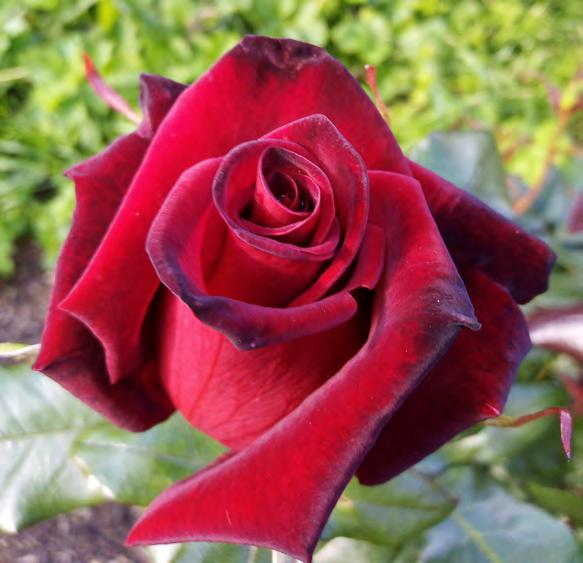
My “heirloom” roses are not those. My heirloom rose garden will be populated with many of the hybrid tea roses propagated by my dad and his dad before him. While I was growing up, my dad maintained a collection of at least two dozen roses in a couple of beds in his yard in Louisville. Some of those roses he transplanted from his dad’s house in Louisville’s Germantown neighborhood.
I’d like to have all the roses he grew, but unfortunately, he never wrote down what was where in the garden, and some of the names have been lost to my memory. I remember that he grew the ‘Peace’ rose, which he dug up from his dad’s backyard. ‘Peace’ is probably one of the most famous roses ever created, hybridized just after World War II and named for the hope that a conflagration such as that war never happens again.
He had another rose, a small bush covered with deep red, almost black blooms. I would love to have it again. But even after pooling my memory with my sister’s, we couldn’t
come up with the name.
We did come up with six roses he grew, and after scouring catalogs, I have found them:
‘Mr. Lincoln’ — Almost as famous as ‘Peace,’ but a deep, dark red. It is also one of the most diseaseresistant hybrid teas and a good choice for beginners as well as seasoned rosarians.
‘Medallion’ — Most roses in the pink/ yellow range of hues sport a couple of colors, but ‘Medallion’ is an almost pure apricot color.
‘Tiffany’ — A pinkand-yellow blend, more pink than yellow, and an excellent choice for cutting or exhibiting at rose shows.
‘Garden Party’ — Almost pure white but with touches of pink. Another good exhibition or cut rose. But know that it is almost ferociously thorny.
‘Chrysler Imperial’ — A red slightly less intense than ‘Mr. Lincoln’ but incredibly fragrant. (Many modern roses have little or no fragrance.)
‘Love’ — The only grandiflora Dad would allow in his garden, ‘Love’ is red with white reverse. It’s a striking plant because it blooms profusely. I’ve counted as many as 20 blooms on the plant during its first flush in spring.
My new rose garden will start with those six. We’ll see what transpires from there.
ROSE CULTURE
If you are new to planting roses, keep one word in mind: drainage.
Do not attempt to plant roses where water stands after a rain for even part of the day. Poor drainage has killed more roses than disease and insects.
gardening
74 KENTUCKY MONTHLY MAY 2024
Some rosarians call for digging a large, 2-by-2-foot, 2-foot deep (at least) hole for your rose bush to achieve the drainage required. While a good-size planting hole is important, I think it’s better to site your roses in a spot that drains well naturally.
Another requirement is sun. Roses simply won’t bloom well in the shade. A little afternoon shade is fine, but the plants need at least seven to eight hours of sun to bloom at their best.
Once you find a sunny, well-drained spot, dig a hole at least twice the diameter of the root ball, spread out the roots, and fill in with the dirt that came from the hole. I sometimes use a little well-rotted manure to add to the dirt, but I otherwise don’t use soil amendments. Mound the dirt up so it’s just above the graft, or swelling, of the stem, and water the dirt in to let it settle. Don’t squash it down with your feet.
Roses are thirsty creatures and should get the equivalent of an inch of rain a week either naturally or by irrigation. If you have a large bed of roses, it might pay to invest in soaker hoses to keep the plants wellwatered, especially during their establishment year.
If you bought No. 1 grade plants, you should get blooms the first year.
Some gardeners pluck the blooms the first year to force more foliage growth, but I’ve never seen much advantage to that.
Aphids and Japanese beetles will likely be the most persistent insect pests. Aphids can be dispatched with insecticidal soap or a strong blast of water. Japanese beetles will likely arrive in June and can be dealt with by hand picking or using a pyrethrin-based insecticide. Try to avoid spraying blooms if possible.
The challenge for the rose grower is fighting disease, particularly black spot. Black spot presents as yellowing leaves speckled with black spots that tend to hit the lower leaves first. You can now buy fungicides that can be poured around the plant that claim to protect from black spot year-round. I haven’t tried them. Or you can spray a fungicide like Mancozeb or Daconil (Funginil) on the plant after every heavy rain. Removing diseased leaves also goes a long way to controlling black spot. If all of that sounds like a lot of work, remember that the toughest task for the rose grower is fighting variety addiction—the need to have them all!
Readers may contact Walt Reichert at editor@kentuckymonthly.com


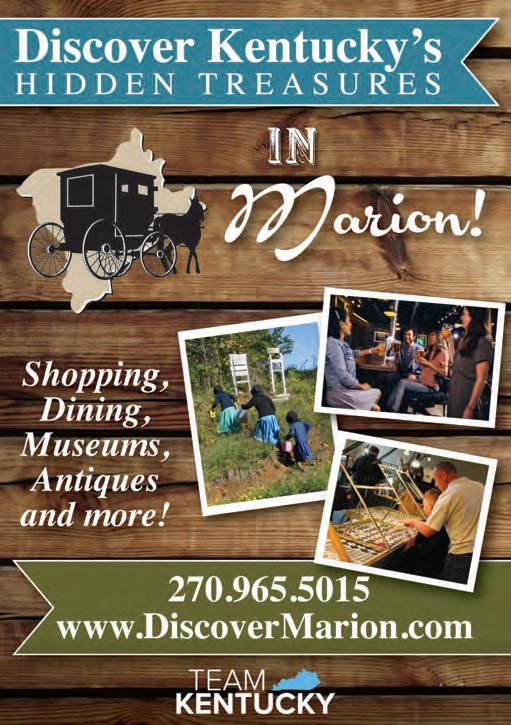
Scan the code to order from our website or call 800-259-4769 Products from the ocean, to set your plants in motion! Family Owned C M Y CM MY CY CMY K kentuckymonthly.com 75
by Gary Garth
Hatchery Creek, Revisited
The conversation turned to trout fishing and where we might soon rendezvous for an upcoming trip. My first thought was the Cumberland River tailwater, but the recent generation schedule had been unfriendly to wading anglers and shorebound fishermen, which we would be.
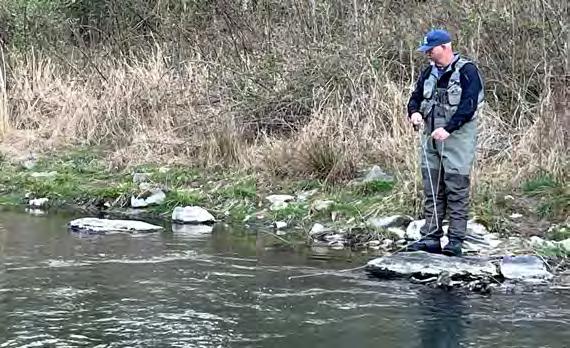
My friend Alan Clemons, a skilled and deeply experienced Alabamabased bass angler but a novice in the trout and fly world, had done some online angling research.
“How about Hatchery Creek? Isn’t it at the hatchery?” he asked.
“It is.”
“Ever fish it?
“A couple of times.”
“And?”
This was, as modern communications between distant friends now often are, a text exchange. While considering my response, my phone dinged.
“???”
“It’s an odd place,” I typed. “Odd?”
“Yeah. It’s loaded with trout, though. Let’s meet there.”
Dates were agreed upon for a Tuesday and Wednesday in late March. I arrived on Monday afternoon with about an hour of daylight left and went straight to the creek, where I missed a fish on the second cast and later caught a feisty brook trout. The fast action wouldn’t last. Clemons arrived later.
The rain started around midnight, not heavy but steady, and continued until about 3 the next afternoon.
We waited, impatiently.
By the time we got to the parking lot and assembled tackle, the sky had cleared, and the wind had shifted from the northwest.
Clemons pulled on chest waders while I donned knee boots.
“You won’t really need those,” I said. “Everyone wears them, but no one wades. At least not more than ankle deep. Unless you want to cross the creek.”
Considering the desire to occasionally cross the narrow stream, I traded knee boots for hip waders, and we made the short walk to the water.
Hatchery Creek flows for slightly more than a mile (about 6,000 feet) across federal property below Wolf Creek Dam in Russell County. Its practical purpose is to return water from the Wolf Creek National Fish Hatchery to the Cumberland River. It’s a pretty place, with a natural look and feel, but it is unlike any trout stream I’ve ever fished because every inch of it is manmade. Each rock, boulder and piece of woody cover in the creek was placed to provide an optimal trout habitat; the gravel bed
(more than 1,800 tons) was designed and placed to provide what biologists deemed would be prime trout-spawning cover.
The stream flow is a constant 25 to 35 feet per second. It flows clear and cold and is surprisingly deep in places. Every spot looks fishy.
For management purposes, the creek is divided into an upper and lower section. The upper section is directly below the hatchery and most easily accessed from the hatchery parking lot (handicapped parking is available next to the stream). This upper stretch is only about 400 feet long and is loaded with trout. Anglers can keep five per day. The park-like surroundings are clean, safe and kid friendly.
About a 3-foot drop separates upper Hatchery Creek from lower Hatchery Creek. The lower stream winds through a thick, bushy landscape for nearly a mile before dropping through a series of rocklined pools to the Cumberland River. Fish move up from the Cumberland into the creek, which holds rainbows, browns, brook and cutthroat trout. The lower creek is managed as catchand-release, artificial lures only.
Trails flank the creek, and it’s all public property, so access is not a problem. But Hatchery Creek is not an easy place to fish. This, too, is by design.
After years of planning, development and construction, the creek opened during the winter of 2015-16. The surrounding landscape was then raw, open and ugly, dotted with freshly planted saplings and a few standing trees. Timber that had been cut or pushed aside during the
field notes 76 KENTUCKY MONTHLY MAY 2024
. . .
Alan Clemons dead drifts a deep run on lower Hatchery Creek. Slightly more than 1 mile long, the man-made stream, which returns water from the Wolf Creek National Fish Hatchery to the Cumberland River, is something of a technical fishery.
creek’s construction was left where it lay. The plan then, according to fishery officials, was for the property to be left and managed “wild and wooly.” It would be allowed to grow thick, bushy and thorny. Anglers’ use of the creek-side trails would keep some foliage at bay, but it would be allowed to grow unimpeded, and it has. It’s a year-round fishery, but stifling heat, an overgrowth of cover and an abundance of bugs—including critters that bite and sting—can sometimes make summer angling particularly challenging.
The trout, however, are there— strong, healthy and wary. A few reach the magical 20-inch mark. Thanks to creek designers, they have plenty of places to hide, including several undercut banks deemed “lunker bunkers” by creek builders. Stealth and a drag-free float are highly recommended. Fly fishermen who employ a strike indicator generally enjoy more hookups than those who don’t. If you’re not finding fish, lighten your tippet and reach for a number 20 or smaller midge. Red is a popular color, but it doesn’t always translate to success. Don’t hesitate to experiment.
My friend spotted several fish but enjoyed no hookups. This is not an uncommon experience for first-time visitors. His assessment of Hatchery Creek was also not uncommon for first time visitors:
“I’ll be back.” Me, too.
Hatchery Creek is open year-round, sunrise until sunset. A fishing license and trout stamp are required for anglers aged 16 and older unless license exempt. Details at fw.ky.gov.
A Hatchery Creek live webcam (updated every 60 seconds) can be viewed at https://wcnfh.com/cam0.php
Readers may contact Gary Garth at editor@kentuckymonthly.com
June 1-2 and June 8-9 23.00 per person ages 1 and up. $


Tickets: DayOutWithThomas.com



CELEBRATING OUR ANNIVERSARY! th
June 7–June 29 THE 39 STEPS
July 2 – July 20 THAT BOOK WOMAN
July 23–August 10 FIREFLIES
August 15, 16, 17 WE THREE KINGS: AN ELVIS EXPERIENCE with live band Kashmere!
Home-cooked BBQ meal with all the fixin’s! Dinner: 7:30 pm | Show: 8:30 pm
to pioneerplayhouse.com or call 859.236.2747 for more information
Stay overnight in Historically Bold Danville! danvillekentucky.com

kentuckymonthly.com 77
. . .
• 136
Main Street New Haven, KY
KENTUCKY RAILWAY MUSEUM
South
• 800.272.0152 • www.kyrail.org
Go
75 2024
THEATRE UNDER THE STARS
Ongoing Radiance Exhibit, Headley-Whitney Museum, Lexington, through June 23, 859.255.6653
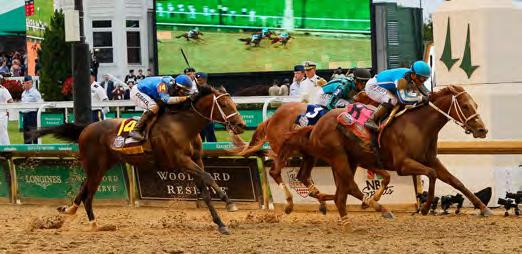
Ongoing Ground to Sky: The Sinkhole Reimagined, National Corvette Museum, Bowling Green, through Sept. 15, 270.781.7973

Shrek: The Musical, EKU Center for the Arts, Richmond, 859.622.7469
8
George Thorogood and the Destroyers, Carson Center, Paduach, 270.450.4444 2
Comedian Rodney Carrington Mountain Arts Center, Prestonsburg, 606.886.2623 4
Chicago: The Musical, Norton Center for the Arts, Danville, 859.236.4692 17
Seedlings in Steam: To The Galaxy & Beyond, Living Arts and Science Center, Lexington, 859.252.5222
Kentucky Oaks, Churchill Downs, Louisville, 502.636.4506 9
Paris Storytelling Festival, downtown Paris, 859.707.6890
Kentucky Derby, Churchill Downs, Louisville, 502.636.4506
11
Corvette Cruise-In, Wilderness Trail Distillery, Danville, 859.402.8707
18
Howie Mandel Live, Paramount Arts Center, Ashland, 606.324.0007
Tracy Byrd in Concert, Amp at Log Still Distillery, Gethsemane, 502.917.0710
Emmylou Harris in Concert Kentucky Theatre, Lexington, 859.231.6997

Great American Brass Band Festival
Danville, through June 1, 859.319.8426
Roots & Boots Tour Beaver Dam Amphitheater, Beaver Dam, 270.298.0036
Kentucky Sheep and Fiber Festival, Masterson Station Park, Lexington, through May 19, 859.246.0911
Bottle Your Own Bourbon Event, Casey Jones Distillery, Hopkinsville, 270.839.9987
Capturing the West: Timothy O’Sullivan Exhibit, Speed Art Museum, Louisville, through July 31, 502.634.2700 Ongoing Stitches in Time Exhibit, Kentucky Museum, Bowling Green, through July 26, 270.745.2592 10
SUNDAY MONDAY TUESDAY WEDNESDAY THURSDAY FRIDAY SATURDAY
3
22
25
20 a guide to Kentucky’s most interesting events calendar
15
For a more extensive listing of events, visit kentuckymonthly.com. 24 Chicago
Concert
Mage wins the 2023 Kentucky Derby
in
, Louisville Palace, 1.800.745.3000
Ongoing
12
Mother’s Day 16
23
31
27 Memorial Day 5
78 KENTUCKY MONTHLY MAY 2024 MAY 2024 19 26 1
21
<<<
30 <<<
downtown
Mark Zerof photo




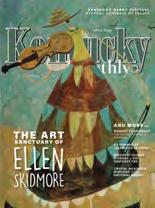


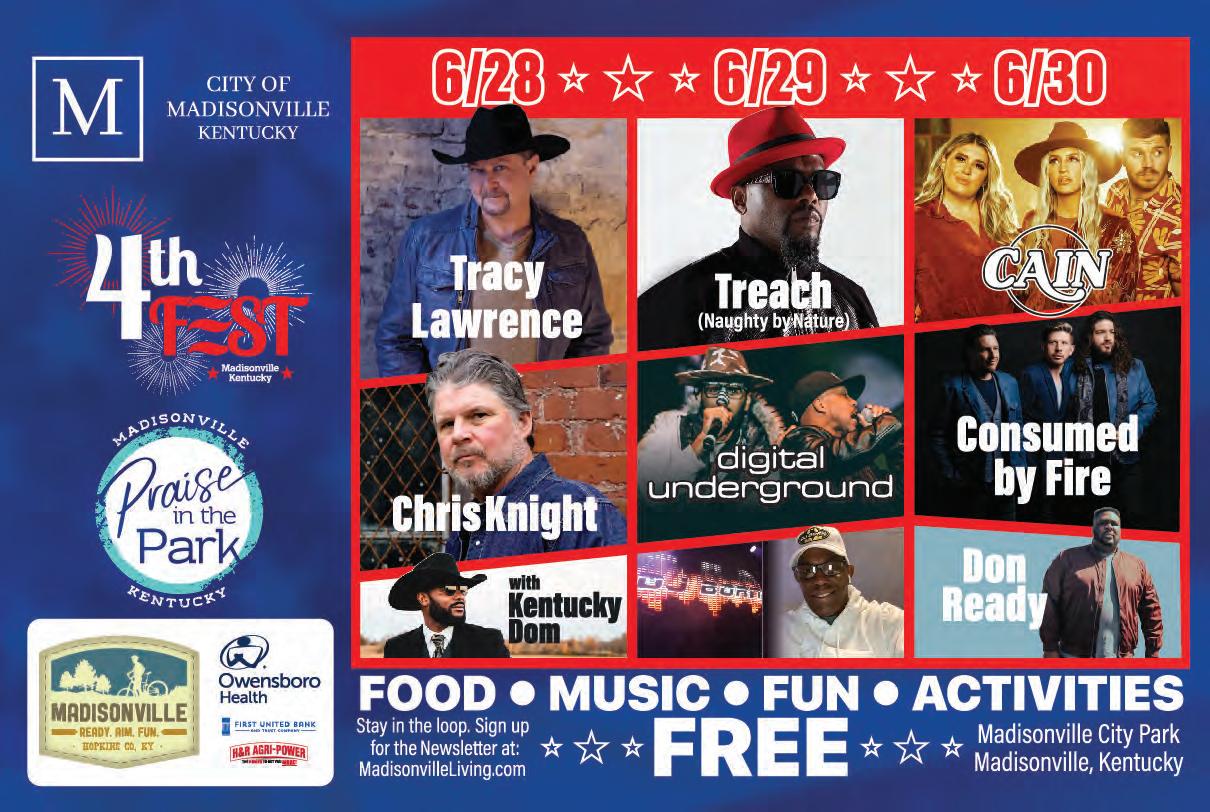
Uniting Kentuckians Everywhere KENTUCKYMONTHLY.COM 888-329-0053 SCAN TO SUBSCRIBE THE MAGAZINE THAT CELEBRATES THE PEOPLE, PLACES, EVENTS + CULTURE OF THE COMMONWEALTH Q SUBSCRIBE TODAY $ 25 ONE YEAR $ 40 TWO YEARS $ 50 THREE YEARS . .
Kentucky Continuum
Pardon me if this column is a bit disjointed. It’s been through a lot.
The first weeks of April were a whirlwind with no apparent outcome. Coach John Calipari’s days were numbered after Oakland University upset Kentucky in the first round of the NCAA Men’s Basketball Tournament—but no, he’s going to stay—wait, no, he’s leaving for Arkansas. Arkansas? No, Calipari’s back. He and Mitch Barnhart will work things out. Calipari’s staying. He’s going. He’s gone.
Calipari managed to upstage a total eclipse.

Coach Mark Pope with his wife Lee Ann and daughters Ella, Avery, Layla and Shay
Baylor coach Scott Drew nope. UConn’s Danny Hurley—never mind. All we knew for sure was that O.J. Simpson would not be the coach.
With between 600 and 6,000 members of the Big Blue Nation having the tailfin number of alumus Joe Craft’s private airplane, we were quickly reminded that “fan” is derived from “fanatic” as they tracked Craft’s every move.
Mr. Craft just left Waco, Texas.
 STEPHEN M. VEST
Publisher + Editor-in-Chief
STEPHEN M. VEST
Publisher + Editor-in-Chief
Mr. Craft is in New York to pick up Rick Pitino … nope.
Eventually, it became clear that Mark Pope, a member of UK’s 1996 national championship team, would be the next coach. Less than 48 hours later, more than 21,000 UK faithful flooded Rupp Arena to welcome Pope from his previous post at Brigham Young University.
Pope said all the right things. UK is once again Kentucky’s team. It’s no longer focused on getting young men ready to play in the NBA; it’s about representing the school and our Commonwealth, and winning. “Our job here, our assignment, is to win banners … national championships,” Pope said.
That 21,000 people would show up on a glorious Sunday afternoon to hear a press conference shows Kentuckians’ passion for the Wildcats.
“C-A-T-S! Cats! Cats! Cats!”
At press time, there are still questions. Will Reed
Sheppard return for his sophomore year? How many of Calipari’s blue-chip recruits will follow him to Fayetteville? How many current UK players will enter the transfer portal or the NBA draft?
Why is this such a big deal?
To understand Kentucky, you must understand basketball. It’s been Kentucky’s unifying force since the 1930s.
For the past several years, Kentucky’s fans have become disconnected from their team. Players come and go without enough time to connect, a fundamental truth in being a Kentuckian.
Along came Reed Sheppard. He represents what’s been missing. He is the son of Jeff Sheppard, Coach Pope’s former teammate and two-year roommate, and Stacy Reed Sheppard, a UK women’s basketball star. Not only do we think we know Reed, we also know his parents, which is vital in a state where many of us describe our families in terms of generations.
“For a while now, players have had a stronger connection to the coach than allegiance to the school,” said Tom Stephens, the author of First Cats: Amazing Origins of the UK Sports Tradition, explaining today’s players and why freshman D.J. Wagner, the grandson of the University of Louisville great Milt Wagner, chose UK over UofL. He didn’t choose a school; he chose Calipari—who coached his father, Dajuan, at the University of Memphis. “This is the future.”
UK fans have little need for that future. They want to be reconnected. Reed’s connection goes back to his parents; by association, it goes back to five young men he’s probably never heard of—Joel White Guyn, R.H. Arnett, H.J. Wurtele, Lee Andrews and Joe Coons, who faced Georgetown College on a snowy afternoon in 1903 in UK’s first basketball game.
“I’ve been a Cats fan since …” is a touchstone to many, whether your first UK hoops idol was the Unforgettables or Rex Chapman or Kenny “Sky” Walker or Jack “Goose” Givens or Dan Issel or Cotton Nash or Cliff Hagan. It defines your generation and how you fit into something larger than yourself. It’s not about being a blue-blood—or maybe it is.
Kwiz Answers: 1. A. William McLean discovered coal in 1820, which eventually led to strip mining in the town and the John Prine song “Paradise”; 2. C. Green, as Prine requested in his song “Paradise”; 3. B. Berea was integrated until a new state law forced segregation in 1904; 4. B. Berea-educated Woodson earned a Ph.D. from Harvard in 1912; 5. B. General admission is $87, but don’t count on seeing a horse other than on the big screen; 6. C. The part of the state east of a line from West Point to Monticello got at least a trace of snow that day; 7. B. The first permanent settlement west of the Allegheny Mountains, Harrodsburg celebrates its 250th anniversary this year; 8. C. Potts played Mary Jo Shively, the head designer at Atlanta-based Sugarbaker & Associates; 9. C. Leslie, a Kentucky governor (1871-75), was the territorial governor of Montana from 1887-89, and Ford was the 12th governor of the state (1941-49); 10. False. Taylorsville is named after Zachary’s father, Richard, upon whose land the county courthouse sits.
vested interest
80 KENTUCKY MONTHLY MAY 2024

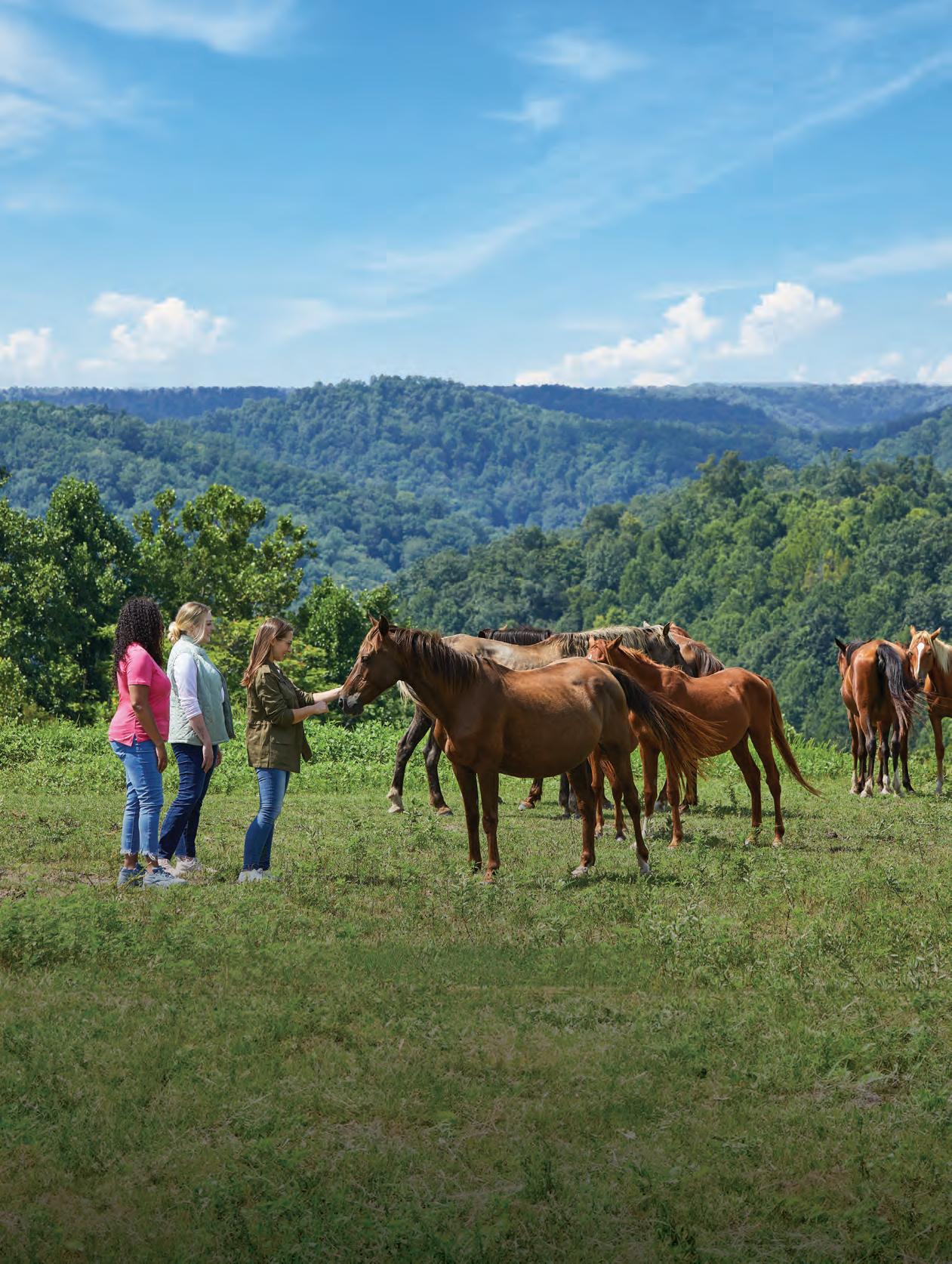

FEEL THE UNIQUE BOND BETWEEN HUMANS AND HORSES. Throughout Kentucky, people and horses share a special connection. Feel it for yourself on farm tours or scenic trail rides across the state. Plan your trip at kentuckytourism.com.
Appalachian Horse Project, Hindman

































































































































































































































 STEPHEN M. VEST
Publisher + Editor-in-Chief
STEPHEN M. VEST
Publisher + Editor-in-Chief


